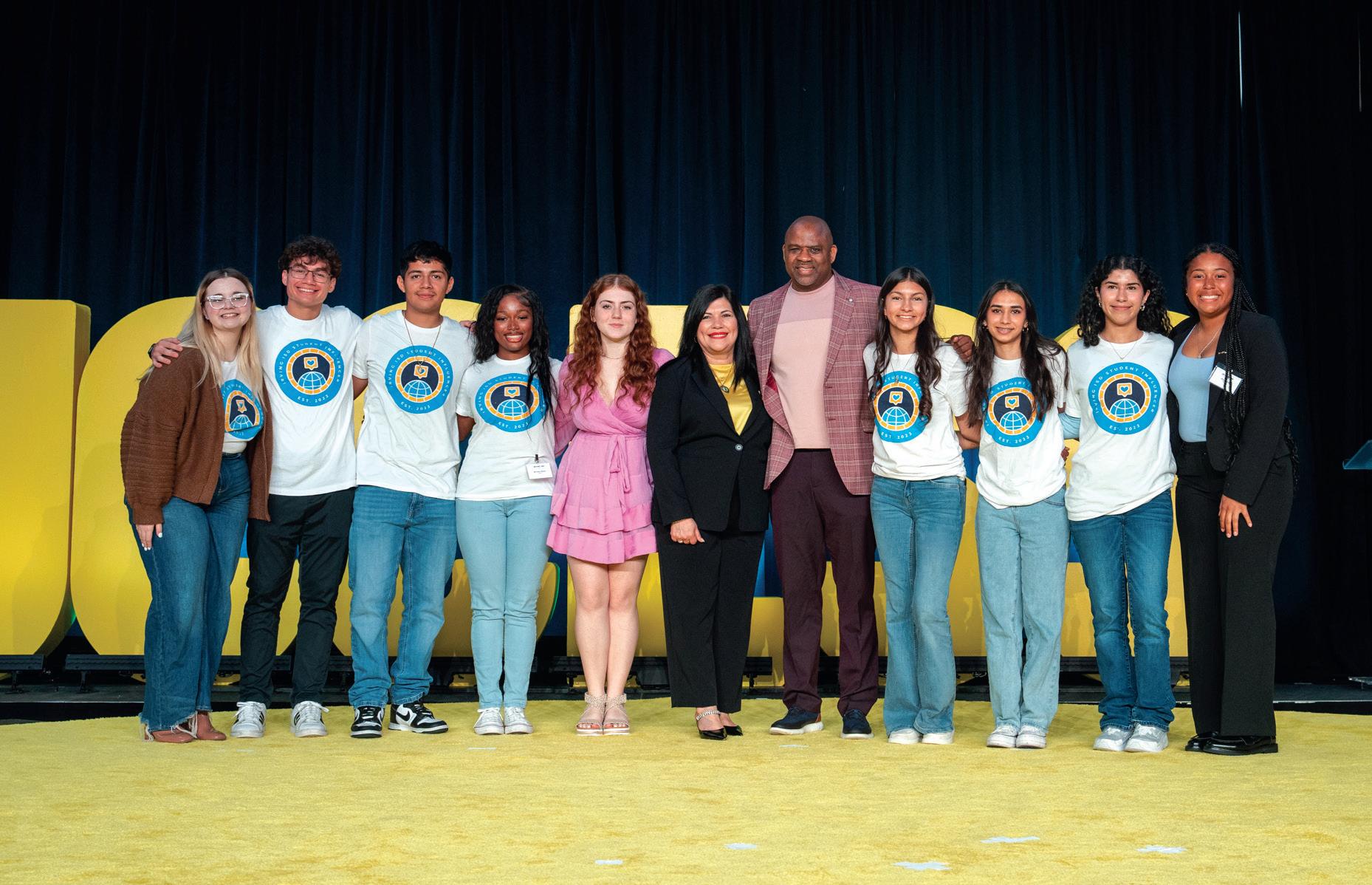




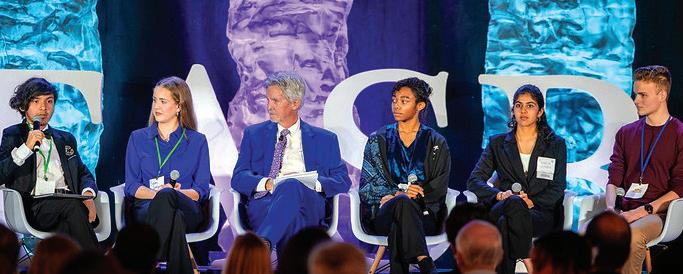
TASB Officers 2024-25
Rolinda Schmidt, President, Kerrville ISD
Tony Hopkins, President-Elect, Friendswood ISD
Mary Jane Hetrick, First Vice President, Dripping Springs ISD, Region 13B
Dan Micciche, Second Vice President, Dallas ISD, Region 10C
Sylvia Sánchez Garza, Secretary-Treasurer, South Texas ISD, Region 1B
Armando Rodriguez, Immediate Past President, Canutillo ISD
TASB Board of Directors 2024-25
Moises Alfaro, Mathis ISD, Region 2
Rose Avalos, Aldine ISD, Region 4A
Carlos Bentancourt, Slaton ISD, Region 17
Lynn Boswell, Austin ISD, Region 13A
Darlene Breaux, Alief ISD, Region 4B
Steve Brown, Ector County ISD, Region 18
Marlene Bullard, Tornillo ISD, Region 19
Kevin A. Carbó, Mesquite ISD, Region 10D
Crystal Carbone, Pearland ISD, Region 4C
Justin Chapa, Arlington ISD, Region 11C
Julie Cole, Hurst-Euless-Bedford ISD, Region 11A
Thomas Darden, Cooper ISD, Region 8
Dynette Davis, Frisco ISD, Region 10E
Angela Lemond Flowers, Houston ISD, 4D
Rebecca Fox, Katy ISD, Region 4E
Ginger Friesenhahn, East Central ISD, Region 20A
Linda Gooch, Sunnyvale ISD, Region 10B
Angie Hanan, Fort Bend ISD, Region 4G
Carol Harle, Northside ISD-Bexar County, Region 20B
Bryan Holubec, Thrall ISD, Region 13C
Tricia Ikard, Maypearl ISD, Region 10A
Mark Lukert, Wichita Falls ISD, Region 9
Raymond P. Meza, San Felipe Del Rio CISD, Region 15
Steven Newcom, Eagle Mountain-Saginaw ISD, Region 11D
Nicholas Phillips, Nederland ISD, Region 5
Quinton “Q” Phillips, Fort Worth ISD, Region 11B
Margaret Pruett, Victoria ISD, Region 3
Tony Raymond, Sabine ISD, Region 7
Keri Roberts, Goldthwaite CISD, Region 12
Alison Busse Savage, Lyford CISD, Region 1A
Rich Sena, Boerne ISD, Region 20D
Cindy Spanel, Highland Park ISD-Potter County, Region 16
David Sublasky, ESC 19, ESC Representative
Greg Welch, Clyde CISD, Region 14
Beth Whittington, New Caney ISD, Region 6A
We want to hear more about what is going on in local school districts around Texas and invite you to send us submissions for our occasional feature, District Voices. Do you have an interesting program to discuss? Lessons learned as a school board member? For submissions or questions, contact managing editor Laura Tolley at laura.tolley@tasb.org. We look forward to hearing from you and your district!


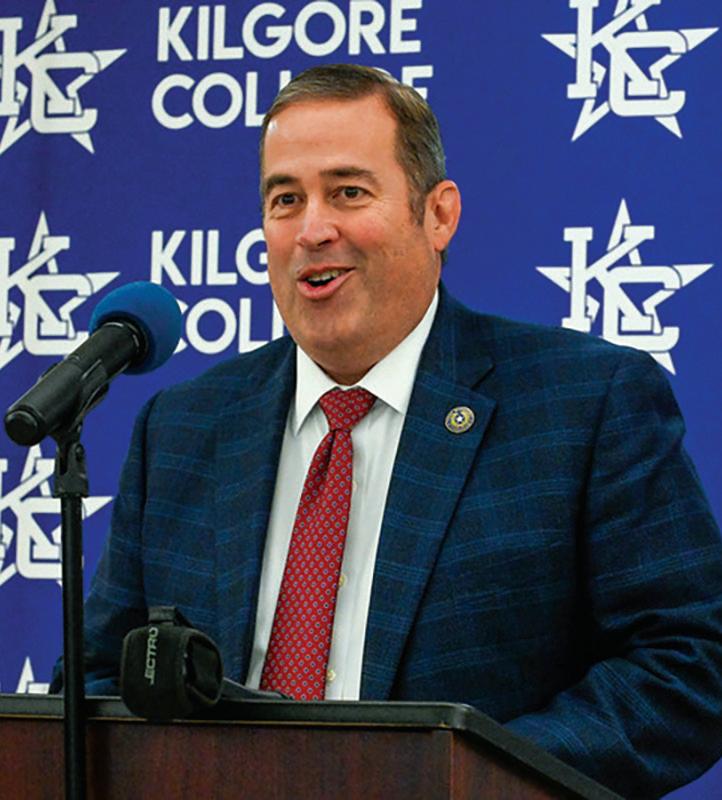
8 Make or Break
Texas legislative session looms large for public schools
Trustees play pivotal role with new superintendents
Texas Lone Star • Volume 43, Number 1
Texas Association of School Boards
P.O. Box 400 • Austin, Texas • 78767-0400
512-467-0222 • 800-580-8272
Laura Tolley • Managing Editor
Shu-in Powell • Graphic Designer
Lalo Garcia • Photographer
360 Press Solutions • Printer
Contributors: Brianna Garcia, Dax González, Beth Griesmer, Mary Ann Lopez, Theresa Gage-Dieringer, Sylvia Wood, Sara Butler, John Pyle, Cheryl Hoover, Vanessa Diamos
Cover design: John Pyle
Texas Lone Star (ISSN 0749-9310) is published six times a year by the Texas Association of School Boards. Copyright© 2025 by the Texas Association of School Boards (TASB). All rights reserved. Reproduction, adaptation, distribution, and exhibition in whole or in part are prohibited under penalty of law without the written license or permission of TASB. Copies of Texas Lone Star are mailed to trustees of TASB member school boards and their superintendents as part of their membership. Subscriptions are available to nonmembers for $36 (1 year), $69 (2 years), and $99 (3 years). Single copies are $5.
Address changes should be sent to Michael Pennant, TASB, P.O. Box 400, Austin, Texas 78767-0400.
Articles in Texas Lone Star are expressions of the author or interviewee and do not represent the views or policies of TASB. Permission to reprint should be emailed to communications@tasb.org or addressed to the Managing Editor, P.O. Box 400, Austin, Texas 78767-0400.
Public education’s crucial role in workforce development
Texas Lone Star does not guarantee publication of unsolicited manuscripts.
Postmaster: Send address changes to TASB, P.O. Box 400, Austin, Texas 78767-0400.



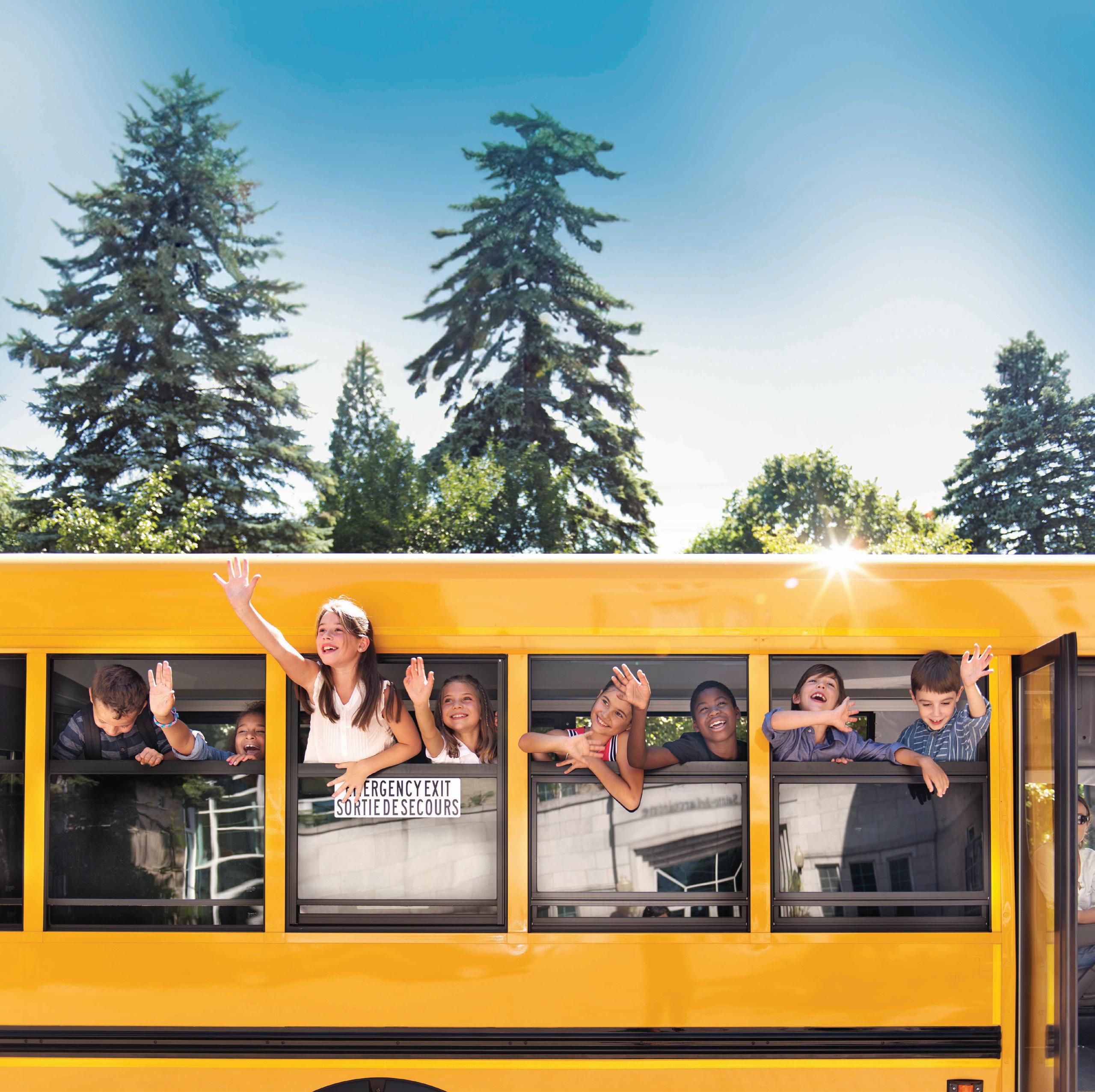
by Rolinda Schmidt
Sailing was my passion growing up. I fondly remember trips to the Texas Gulf Coast, where I was taught to navigate a 14-foot Sunfish sailboat through the waters of Little Bay in Rockport. I quickly learned the importance of the center keel to keep the tiny vessel stable and from toppling over, the sail to provide forward movement, and the tiller and rudder to control direction.
Serving as a school board trustee is much like sailing. To be most effective, we learn to navigate our important work to ensure the best education is available for our students through balance, forward thinking, and sound direction.
A new year has begun and the 89th Texas Legislature is underway. I’m reminded of a line from Ernest Hemingway’s Old Man and the Sea, “Now is no time to think of what you do not have. Think of what you can do with what there is.”
As our lawmakers file bills, promote agendas, and debate the merits of their positions, we as advocates for public schoolchildren will be doing what we can with what there is. And what there is includes incredible and moving stories of student successes as well as challenges for districts across Texas. As we tout our achievements, we must also share with our legislators the impacts of proposed legislation on our students, our teachers, and our local communities.
We are all advocates
And we will. The State Board of Education’s Framework for School Board Development includes a critical area of focus for school boards, which is to recognize the respective roles of and provide input and feedback to the Legislature, SBOE, and the Texas Education Agency
to ensure maximum effectiveness and benefits to Texas schoolchildren.
As part of our advocacy work, we have a wonderful opportunity to meet in Austin on Feb. 18 for the TASA | TASB Legislative Conference. This free event will provide attendees with updates on legislative activity and proposed bills.
The day begins with presentations from key legislators and others and concludes with afternoon visits to the offices of our state representatives and senators, where we can share our legislative priorities.
If you are a newly elected trustee, the Capitol visit can be a bit intimidating, so partner with others from your region and schedule your visit together. Plan to share information on the impacts of proposed legislation on your district and community. If you have questions about the conference or how to schedule and prepare for the Capitol visits, contact TASB Governmental Relations at tasbgr@tasb.org.
In our work, we often get the opportunity to talk to local and state leaders about public education. It’s incumbent upon us to advocate for public education to these key stakeholders. But I also believe it’s important to ask your lawmakers how you can be of help to them in the work they are doing to best serve public schools. To establish meaningful and impactful relationships with your legislators, seek common ground and model civility. Become a trusted community resource in their decision making.
A group of engaged trustees and school leaders recently attended the Texas Federal Advocacy Conference in Washington, D.C. The conference featured in-

fluential speakers and educational panels. Attendees also met with legislators at the U.S. Capitol.
Here at TASB, the new year starts the all-important cycle of providing training opportunities for trustees, beginning with Governance Camp: Powered by Student Voice. Held March 5-8, this event is where governance, leadership, and student voice all come together. Set against the beautiful Galveston coastline, board members and superintendents will attend keynotes and sessions that provide tools and knowledge to steer your district forward. The studentled presentations and demonstrations are a Camp highlight, and the Student Voice Scholarship panel is a learning opportunity trustees will not want to miss.
As mentioned in my inaugural column, a primary goal of mine is to attend area association meetings to share information on the many services TASB offers you as trustees and your district’s operations teams and learn how TASB can better serve these vital roles.
I am excited to be attending my first area association meeting in North Texas. I appreciate the invitation from Julie Cole, a Hurst-Euless-Bedford ISD trustee, North Texas Area Association of School Boards member, and TASB Director.
And I look forward to more opportunities to attend area association/coalition meetings across this great state of Texas. Let’s learn and grow together to best serve our future leaders — our students.H
Rolinda Schmidt, a Kerrville ISD trustee, is the 2024-25 president of TASB.
TASB Active Members enjoy the advantages of being part of a nonprofit, nonpartisan, member-led organization that is accountable to school board trustees and public education leaders from across the state.
TASB membership includes:
• Expert legal advice a phone call away
• Trusted resources and publications
• Quality professional development
• Strong advocacy of public education priorities
• Member voice and governance
• Plus a range of elective services, including Policy Service, TASB Student Solutions, Facility Services, and many more
TASB membership also opens the door to potential participation in affiliated entity programs:
• BuyBoard®️
• TASB Risk Management Fund™️
• TASB Benefits Cooperative™️
• TASB Energy Cooperative™️
Learn more about the TASB Advantage, including access to elective programs, services, and products designed to meet the unique needs of school districts at tasb.org or scan the code.
by Laura Tolley
Happy New Year, and welcome to the inaugural February/March issue of Texas Lone Star!
As I mentioned in my November 2024 column, we are starting a new schedule this year for the magazine. We’ll be publishing six issues in 2025 instead of 10.
Our goals with the new publication schedule are to enhance content quality, support a digital-first strategy for tasb.org, and create a more sustainable future for the magazine. We want to make sure that TLS remains a high-quality, must-read publication serving the needs of Texas school board members and other school leaders for years to come.
The bimonthly magazine will continue to deliver in-depth, research-based content about TASB’s services, innovative efforts and programs in Texas public schools, as well as other news about public education. We want our readers to look forward to every issue’s arrival, knowing the time they spend with us will result in new insights — “Wow, I didn’t know that!” — or innovative approaches — “Hey, maybe that’s something we should try!”
The Legislature convenes
This issue features a legislative session preview package that leads with an article by Dax González, division director of TASB Governmental Relations. He writes, in part, about how public schools across the state are facing increasing financial pressures that they hope state lawmakers will address this session.
The legislative package includes valuable tips about how school board members can, and should, be an important part of the advocacy process. There
is information that comes from TASB’s A Toolkit for Community Advocacy: A Guide to Amplify Public Education Support. This new resource equips you with the information and resources you’ll need to talk to lawmakers and state officials about your district and about Texas public education in general. It can be found at tasb.org/resources/communityadvocacy-toolkit
We want our readers to look forward to every issue’s arrival, knowing the time they spend with us will result in new insights.
We also have a feature article about how new superintendents can hit the ground running in their efforts to lead effectively while creating a positive environment in their district. The article offers trustees tips from TASB’s Executive Search Services on how to foster a successful superintendent transition.
Also, check out the Q&A with Alberto Treviño III, who serves as the commissioner representing labor for the Texas Workforce Commission. His office works to enhance strategic partnerships and innovative school programs in Texas. Workforce development is vital to the growing Texas economy, and the TWC is helping public school leaders address that need, which in turn benefits students across the state.

We travel with this year’s Leadership TASB class on its recent visit to the El Paso area, where they visited with local school leaders and students. The field trip is one of several we will be highlighting during the next few months. You can also find information on the Superintendent of the Year nomination process and the upcoming TASB Spring Workshops that will be held in locations across Texas.
Magazine traditions continue I want to point out that the new publication schedule will continue TLS traditions, including one of my favorites, the issue dedicated to good news about Texas students. That feature will be the June/July issue. The August/September issue will include the txEDCON preview, and the December issue will be the TASB annual report.
We welcome feedback and want to hear from you. We are always on the lookout for great stories about Texas public schools and students and look forward to getting ideas from districts and from readers. Let us know what you’re doing. And don’t forget about our “District Voices” column, an occasional feature that local school board members write. If you have an idea for a “District Voices” column, a district story to tell, or a good news item about a student, let me know at laura.tolley@tasb.org. I hope you enjoy the issue.H

Laura
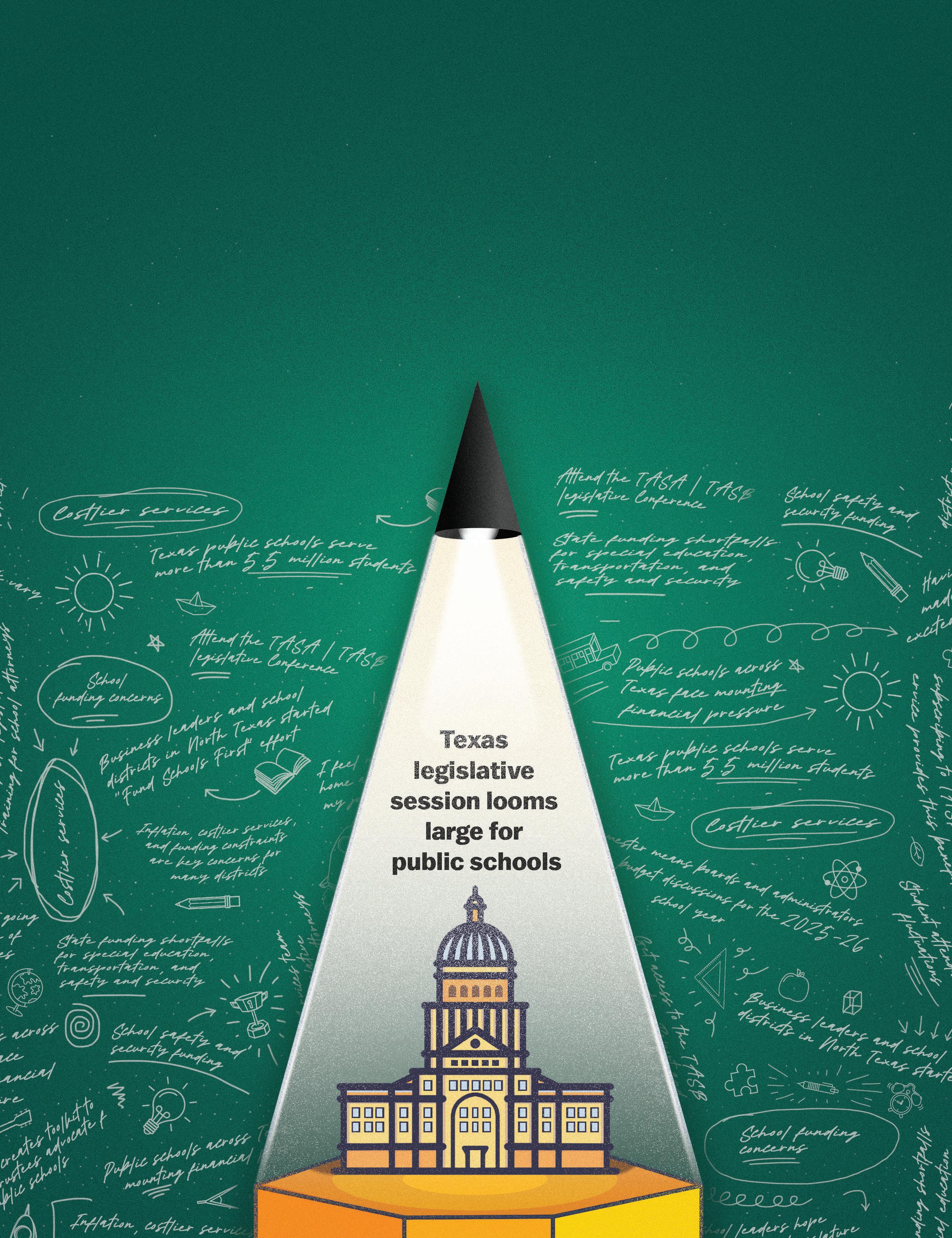
by Dax González
With public schools across the state facing mounting financial pressure, school leaders are hoping — yet again — that the 89th Texas Legislature will help them address pressing needs back home.
As the school year starts the spring semester, school trustees and administrators are beginning budget discussions for the 2025-26 school year with talks of closing campuses, eliminating positions, and cutting back on educational and extracurricular programs.
Trustees have cautioned legislators for years that rising inflation, costlier services, and a funding cliff from the loss of federal COVID relief dollars were resulting in a financial crisis for many districts.
Many school districts held out hope in 2023 that the 88th legislative session would have provided some relief, but $4 billion in state funding for public schools was left on the table when a school finance bill was withdrawn from consideration after the Texas House stripped an education savings account voucher program from it.
That hope has turned into frustration as many political discussions about public education seem to be focused on vouchers rather than increasing the basic allotment to compensate for rising inflationary costs that have jumped by close to 20% since 2019, which is the last time the basic allotment was addressed by the Legislature.
“Dollar funding for public education has decreased by $9.86 billion since House Bill 3 [2019] took effect,” said Lori Tays, a Denton ISD trustee. “I am deeply concerned for student outcomes and the future workforce of Texas.”
Tays, a pediatric emergency room nurse, noted that educators are already seeing some of the negative outcomes associated with a lack of funding, including decreased opportunities for students and a negative impact on academic progress across the state.
“Districts have been doing their best to address each individual funding gap, but at some point, there are just too many to sustain with decreasing buying power caused by inflation.”
— Kelly Rasti, associate executive director of TASB Governmental Relations
As a school board trustee, one of your most important responsibilities is to advocate for the needs of your school district’s students, families, and taxpayers. This can mean communicating with policymakers, raising awareness on important issues, and even advocating for legislative changes.
TASB created A Toolkit for Community Advocacy: A Guide to Amplify Public Education Support to help trustees learn how to ensure they are representing the true needs of their community and to find out how to bring other people along on that journey.


The toolkit includes an array of resources for school board members: Learn the seven steps of community advocacy. Find specific information on how to contact and address state lawmakers. Get step-by-step instructions for organizing a trip to the Capitol to advocate for your district. You can find these resources and more by going to tasb.org/resources/community-advocacy-toolkit, or scan the code above.
Jan. 14: Regular session begins March 14: 60-day deadline to file bills June 2: Sine die — last day of regular session

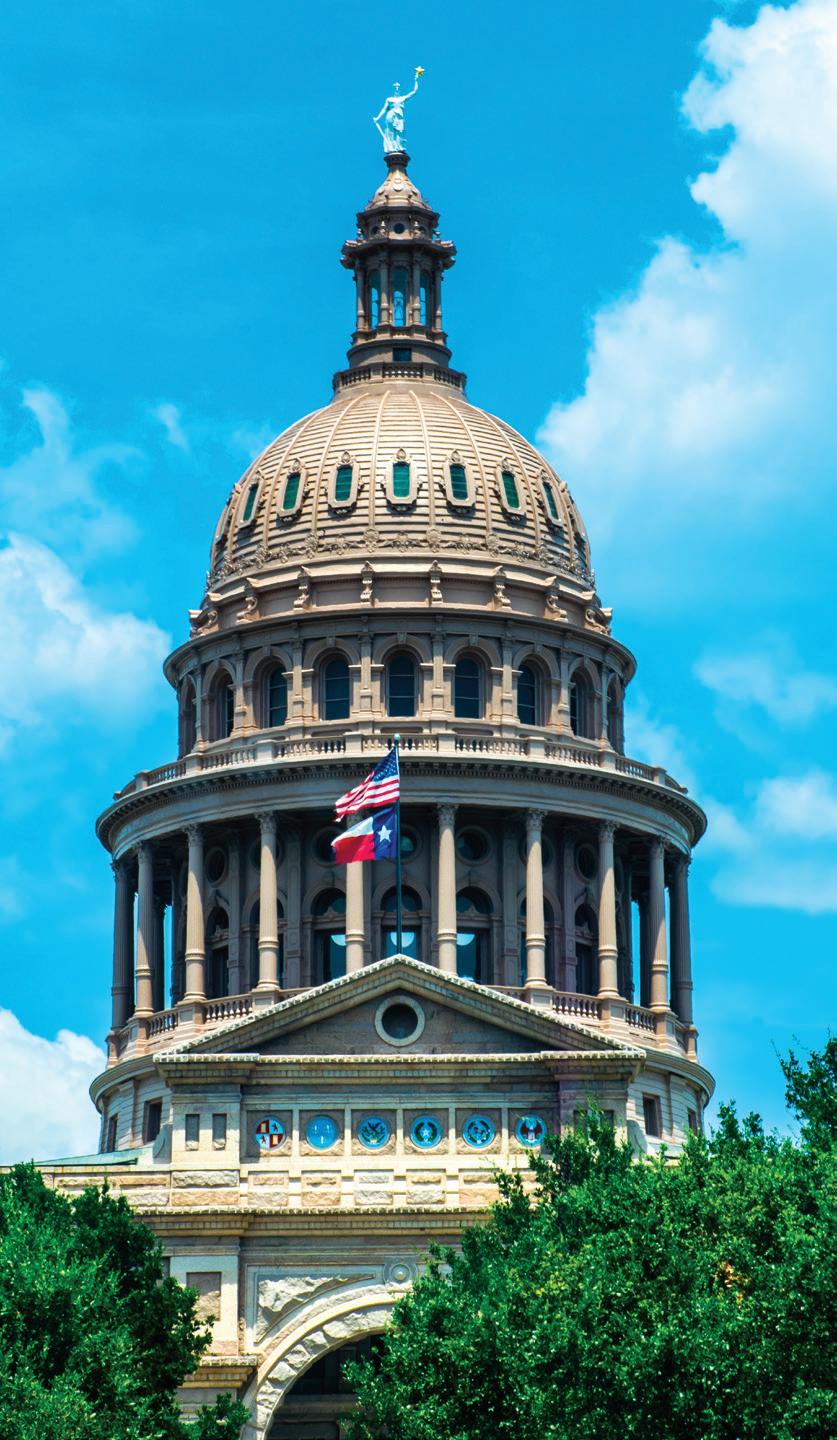
There have been several blows dealt to school districts — compounding the funding problems. District leaders are seeing growing gaps in special education, transportation and school safety funding, challenges resulting from reduced support from the federal Medicaid reimbursement program for children receiving special education services, and reduced revenue from declining student enrollment.
“It’s like death from a thousand cuts,” said Kelly Rasti, associate executive director of TASB Governmental Relations. “Districts have been doing their best to address each individual funding gap, but at some point, there are just too many to sustain with decreasing buying power caused by inflation.”
Rasti, who worked as both a teacher and an administrator in San Antonioarea school districts before joining TASB, knows that schools can manage temporary budget shortfalls, but she added that sustained deficits are a different matter that begins to affect local taxpayers.
“We’ve now reached that point,” Rasti said. “Districts are adopting deficit budgets and are forced to turn to local voters to pass higher tax rates to increase teacher salaries and maintain school campuses.”
Business leaders and school districts in North Texas started a movement to “Fund Schools First,” asking the Legislature to prioritize public education this session before addressing other issues.
The group highlights Texas Legislative Budget Board data showing that, in constant 2016 dollars, education funding has dropped from a high of $66.76 billion in 2021 to $44.9 billion in 2025.
The group also points to significant funding gaps between what schools are spending on students and what the state is providing for those services, including shortfalls of $2.2 billion for special education services, $1.6 billion
in transportation funding, and $747 million for safety and security.
These funding gaps are exacerbated by rising costs in education, including a 22% increase in emergent bilingual students and a 35% increase in students requiring special education services. These students require more qualified staff, specialized services, and other support to meet state standards.
Some point to inflated administrative budgets as a reason for school districts’ financial woes, but Texas Education Agency data show that the average portion of district budgets allocated to central administration is 4%. Those administrators are also dealing with more state requirements every year, sometimes leading to the hiring of more support to comply with the new mandates.
“The magic of public education is that we meet all students where they are and provide support to boost student progress, inside and outside of the classroom.”
— Lori Tays, Denton ISD trustee
In the end, school districts across Texas will continue to work hard to provide the best educational services for their students, even as the state’s investment in those students lags.
“The magic of public education is that we meet all students where they are and provide support to boost student progress, inside and outside of the classroom,” Tays said. “Under the current funding system, those necessities for development will now be viewed as luxuries and our children will suffer the ramifications.”
Like many other trustees, Tays believes legislators can cut through the noise and clutter of the legislative session to focus on the more than 5.5 million students currently attending Texas public schools.
“I am hopeful that our legislators will recognize the importance of public education and its critical role in shaping the future of the Texas economy, and that they will provide adequate funding for our schools in the upcoming legislative session.”H
Dax González is division director of TASB Governmental Relations.
Texas school leaders are encouraged to stay on top of the issues most relevant to public schools by joining TASB’s School Board Advocacy Network. This free service includes access to the TASB Legislative Report and timely alerts about bills that are up for consideration and includes information on how to contact local legislators regarding those bills. Sign up at tasb. org/advocacy/capitol-watch
Individuals who are not school board members or superintendents may subscribe to the TASB Legislative Report by emailing their name, organization, and preferred email address to tasbgr@tasb.org and they may also sign up to receive updates from Texans for Strong Public Schools at tasb.org/advocacy/support-your-publicschools
The TASA | TASB Legislative Conference provides updated information about the legislative session and gives school board members and superintendents the opportunity to meet with legislators and communicate local district needs and priorities.
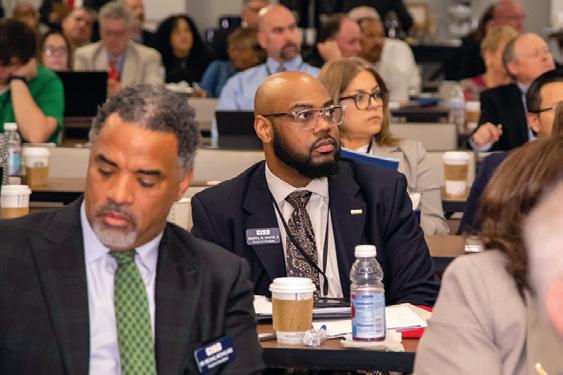
This free, one-day event, which will be held Feb. 18 in Austin, is a collaboration between the Texas Association of School Administrators and TASB. Key legislators and political observers are invited to share their insights on the legislative session and education policy.
The morning session will be held at Downright Austin, A Renaissance Hotel at the Capitol, at 701 E. 11th St. Attendees may visit with lawmakers at the Capitol in the afternoon.
For more information, email tasbgr@tasb.org or call 800-580-4885
The 89th Texas Legislature will be in session for 140 days. That’s a relatively brief amount of time to formulate and approve the state budget, debate and vote on proposed new laws, and propose changes to existing laws. Here is a brief primer on key aspects of the Texas legislative process.*
The Legislature consists of the Texas House of Representatives and the Texas Senate.
On the first day of each regular session, the 150 members of the Texas House of Representatives choose one of their members as speaker of the House. Rep. Dustin Burrows (R-Lubbock) was elected House speaker for the 2025 legislative session.
The speaker presides over the House, keeps order, recognizes members to speak during debate, and rules on procedural matters.
The speaker also appoints committees, committee chairs, and vice chairs.
The lieutenant governor is the presiding officer of the Senate and is chosen by voters, not the 31 senators. Lt. Gov. Dan Patrick was reelected to this post in November 2022.
The first thing the speaker and the lieutenant governor ask the two chambers to do is decide on the rules they will follow during the session. The Texas Constitution provides some legislative procedures, but both chambers can adopt additional rules if they are approved by a majority vote of the members.
After rules have been adopted, the Legislature starts to consider bills, which are proposals filed by lawmakers to change state law by adding a new law or amending a current one.
Once a bill has been written, a member of the House or the Senate introduces it. After a bill has been introduced, a short description of the bill, known as the caption, is read aloud while the chamber is in session so that all members are aware of the bill and its subject. This is the first reading. Next, the presiding officer assigns the bill to a committee.
The chair of a committee decides when the committee will meet and which bills it will consider.
House committees have three kinds of meetings:
• Public hearings, where testimony is heard and where action may be taken
• Formal meetings, where members may discuss and take action without hearing public testimony
• Work sessions for discussion without action
In the Senate, testimony may be heard and official action may be taken at any committee meeting. Public testimony is usually sought on bills so that citizens have the chance to provide input. Legislative witnesses also include representatives of other levels of government like county officials, mayors, school board members, and other subject matter experts.
After considering a bill, a committee may take no action or may issue a report on the bill. The report expresses the committee’s recommendations regarding action on the bill. In the House, the committee report goes to the calendars committee for placement on a calendar for consideration by the full House. In the Senate, bills are placed on the agenda in the order in which they were reported from a committee.
A bill receives a second reading when it comes up for consideration by the full House or Senate. The bill’s caption is read, and the bill is debated by the ful membership of the chamber. Any member may offer an amendment, which must be approved by a majority of the members present. Members then vote on the bill.
The full body then considers the bill again on third reading and final passage. Bills may be amended again on the third reading, but amendments require a two-thirds majority for adoption at this stage.
When a bill receives a majority vote on the third reading, the bill is considered passed. When a bill is passed in the chamber where it originated, the bill is engrossed, and a new copy of the bill that incorporates all corrections and amendments is prepared and sent to the other chamber for consideration. There, the bill follows the same process for that body. When the bill is passed there, it is returned to the originating chamber with any amendments that have been adopted attached to the bill.
If a bill is returned to the originating chamber without amendments, it is signed by the speaker and the lieutenant governor and sent to the governor.
If a bill is returned to the originating chamber with amendments, the originating chamber can agree to the amendments or request a conference committee to work out the differences in the two versions of the bill. If the amendments are agreed to, the bill is signed by the speaker and the lieutenant governor and sent to the governor.
When the governor receives a bill, he may sign it, veto it, or allow it to become law without his signature.
*This is a general description of key aspects of the legislative process. Constitutional amendments have additional rules and there are other parliamentary procedures that may come into play during the legislative process.
The Texas legislative process can be intimidating. But remember, lawmakers are elected by voters like you to represent your interests at the state level, so don’t be shy.
Establishing a relationship with your elected officials isn’t as difficult as it might seem. The first step is reaching out by phone or email. In TASB’s A Toolkit for Community Advocacy: A Guide to Amplify Public Education Support, there are a host of tools, tips, and resources that can help you get started. Following are some of those tips. The entire tool kit can be found at tasb.org/resources/community-advocacy-toolkit
You can find out who represents you and how to contact them by going to wrm.capitol.texas.gov and filling out the form there. Call or email their offices to make an initial contact and introduce yourself.
The first step to building a solid working relationship with your lawmakers is to reach out. Whether you call or write, make sure you:
• Know who your legislator is.
• Know the issues.
• Stay focused.
Before you contact your state representative and senator, gather some basic information about them. Knowing this can help you plan your advocacy strategy:
• Personal information: Knowing some basic background information can help you establish ties to your legislators. Where did they go to school? What do they do for a living? What do you know or can find out about their families before you contact them?
• Committee assignments: Find out which committees your legislators serve on and if they serve as the committee chair or vice chair. This is especially important if they’re on a committee that regularly deals with education issues. However, even if their committee assignments don’t directly impact education issues, their votes do.
• Staff members: Get to know the legislative staffer who deals with education issues, and make sure he or she gets to know you by name. Staff members research the issues and pass along information to their boss, your lawmaker. Establishing a good relationship with them is your foot in the door.
• Voting history: Find out how your legislators voted on earlier education issues. This can help you anticipate where they are likely to stand on upcoming issues and will help you prepare for conversations with them.
As Texas State Rep. Trent Ashby (R-Lufkin) said, the best way to develop a relationship with your lawmakers is to set up a meeting to introduce yourself and get the discussion started. “In doing so, you’ve put a face with a name and have the opportunity to follow up with the member again to remind or update them on the issue.”
Effective advocates use the facts, their personal stories, and their networks to amplify their messages on issues that affect our local schools and children.
Make sure you’re an informed public education advocate:
• Keep up with the headlines from the Texas Legislature by following state and local news sources.
• Follow TASB on Facebook, X (formerly known as Twitter), and Instagram. Share good news related to education and advocacy messages on your own social media profiles.
• Listen to the TASB Talks podcast. Hear from experts in education, members of the Capitol crowd, TASB staff, and more on the big issues that impact public schools.
• Sign up to receive TASB Governmental Relations’ Legislative Report emails. These insider emails are sent regularly with need-to-know information. Visit the Governmental Relations’ Capitol Watch page at tasb.org/advocacy to sign up for emails and find other information.
• Share the Texans for Strong Public Schools website: texansforstrongpublicschools.org. Help your family, friends, and neighbors stay informed and become advocates.
Whether you write or call, make sure to share all the same basic information. And if you can’t get in contact with the official, speak to an aide. Here are the most important things to remember:
• Identify yourself by name and let them know you’re a constituent.
• Identify your role (parent, school board member, teacher, concerned citizen).
• Tell them what issue you are contacting them about.
• Explain the local impact.
• Be clear about how your legislator can help.
• Follow up with a short thank you note.
If you’re reaching out about a specific piece of proposed legislation:
• Mention the bill number.
• Be specific about your position on the bill as it is.
Thank the lawmaker or staff member for taking the time to hear your position. Once you’ve done that, encourage others to echo your message. “It’s true that there is strength in numbers, and as your coalition grows, the louder your message becomes. The more times a member or an office hears about an issue, the more pressure there will be to respond,” Ashby said.
When communicating about a controversial issue, Ashby encourages folks to keep it civil. “It’s always important to maintain a respectful and professional demeanor and remember to adhere to the Golden Rule.”

• Start early: Making a connection before a legislative session begins is important. Visit your lawmakers’ local offices while they’re in their home district to get more of their time.
• Be timely: Contact your legislator before an issue becomes big news, before they take a position. This gives them time to reply. When messaging about an imminent vote, make sure they get the message before the vote. (Phone calls work great for this!)
• Use your own words: Avoid slogans or politically loaded language. If you’re using a form letter, be sure to adapt it to your own personal experiences wherever possible.
• Keep it short: Your legislators and their staff don’t have time for a wall of words. Make sure your message is brief and to the point.
• Keep it focused: Limit yourself to one issue or bill per letter and always mention the bill number. Trying to address multiple issues or bills will dilute the importance of your main point.
• Explain the local impact: Describe how the bill will affect schools and students in your community. Personal experiences or the likely effect of proposed legislation makes for a powerful message.
• Request a response: Ask your legislator for their position on an issue and their reasoning behind it.
• Thank them: When your legislators vote the way you ask, write them a brief note to let them know you appreciate it. If you worked with a member of the staff, include his or her name in the note. This could ensure the member sees your message.
by Beth Griesmer and Mary Ann Lopez
Being the new kid in school is never easy. There are the inevitable worries about making new friends and fitting in, at any age. Very often, how a new student navigates those first few nerve-racking days can impact their entire experience with the school. The same can be said about superintendents transitioning into a new district.
“I try to make each transition better than the last,” said Quintin Shepherd, who took over last year as superintendent of Pflugerville ISD, a district of 25,000 students north of Austin. “This is my fifth transition.”
How a superintendent approaches his or her role in a new district varies by experience, personality, and the needs of the district itself. However, the onboarding process for an incoming superintendent can help determine their success as a leader and the school board can play a pivotal role in creating that positive environment.
The job of superintendent is varied and complex. According to a report released in November 2023 by The University of Texas at Austin College of Education, Untapped Talent: An 11-year Analysis of the Texas Superintendent Workforce, “Each superintendent works in a unique organizational position accountable to numerous stakeholders.”
Superintendents serve not only students, district staff, and families, but they are accountable to their school board, the state education agency, university partners, and nonprofit organizations. That mix of stakeholders includes the larger community, local businesses, and civic organizations. “Like corporate CEOs, superintendent leadership is highly contextualized and situated within a unique organizational, economic, and political environment,” the report stated.
For Shepherd, the transition for a new role starts by gaining an understanding of those stakeholders — even before he gets the job. “The work for the transition begins the minute you apply for the job,” he said. “Even if you don’t end up getting that job, you’ve already started the transition process.”
Applicants start by studying the district and doing their research. “You can learn so much about the district before ever stepping foot in the district,” Shepherd said.
It’s not just about looking at the district website. Shepherd recommends digging deeper and envisioning yourself and your family in that community.
For the new Goldthwaite CISD superintendent, the location was critical for his family. “My situation is very unique,” Christopher Bailey said. “This is the only job I applied for.”
Bailey was working at Abilene ISD as an administrator and aspired to take on a superintendent role. With some encouragement from his superintendent, he applied for the job at Goldthwaite CISD — but not before he did his due diligence.
Research is important for trustees, too.
“I think we all started Googling superintendents,” Renae Mitchell, Pflugerville ISD board president, said about the

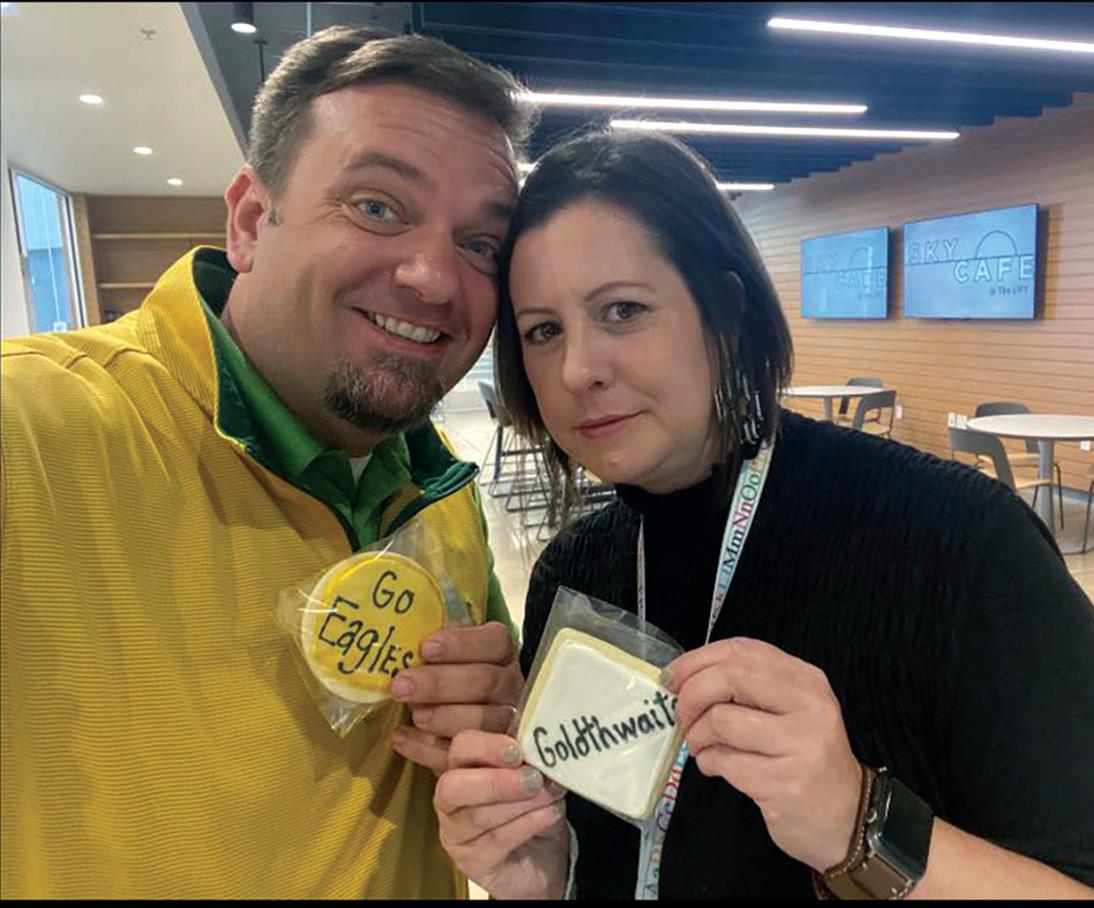
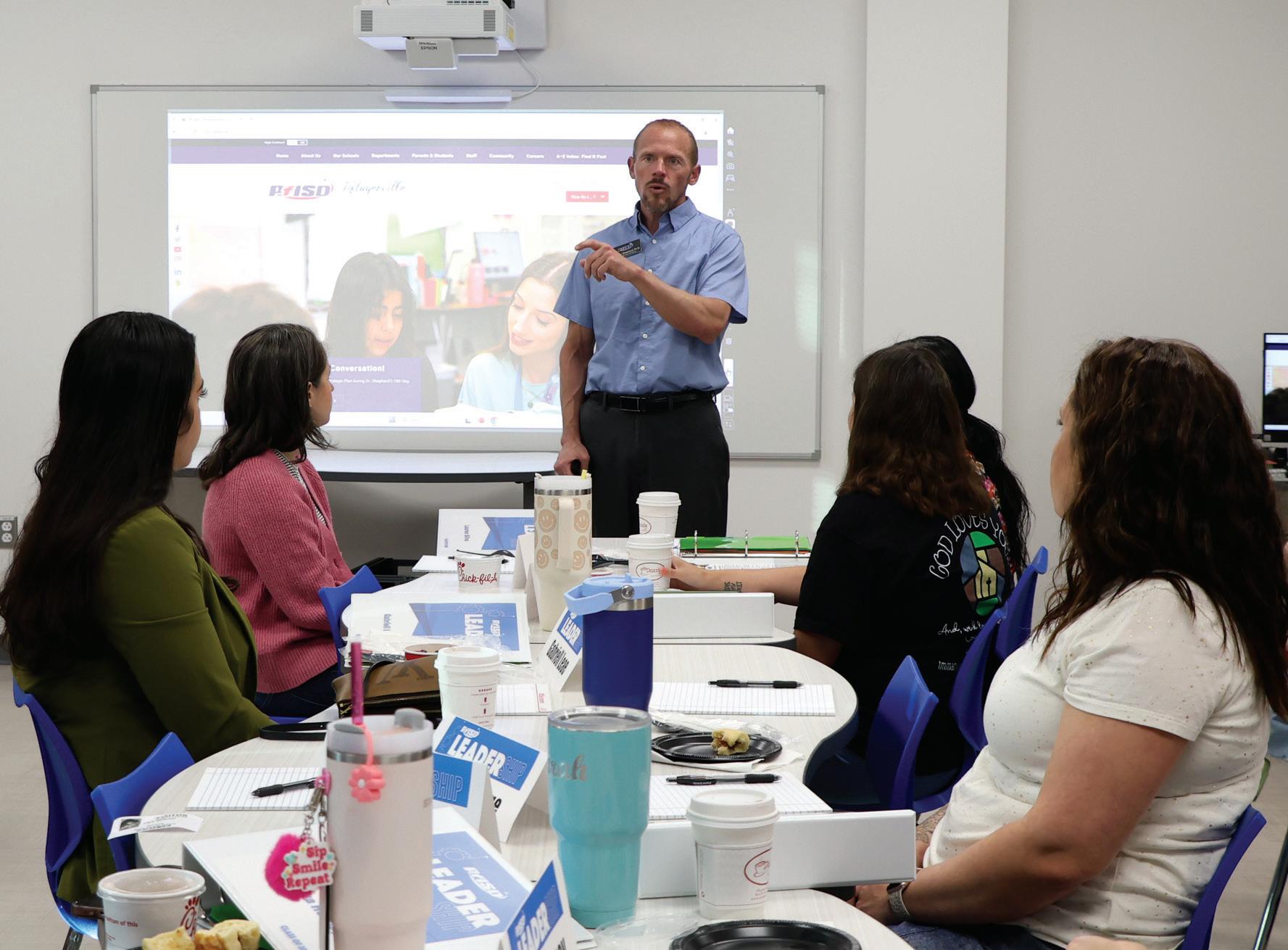
district’s early steps in the hiring process. “Dr. Shepherd showed up in my searches twice.”
Mitchell said the board was looking for mature leadership, someone with five to 10 years’ experience from a district that had shown growth. Shepherd had that kind of experience leading Victoria ISD and districts in the Midwest. “We were looking for the right fit,” Mitchell said.
William Foster agreed. The Caldwell ISD board president discussed his district’s search for a superintendent on a panel during txEDCON24.
“The fit is probably the biggest thing when you are looking for your superintendent. Not just what they’ve done and their experiences, but how they are going to fit in the community.” Caldwell ISD is a growing district of about 2,000 students 80 miles east of Austin.
Ensuring a positive onboarding experience with a new superintendent begins as early as the recruiting process.
During the interview stage, the board and superintendent candidates have the opportunity to get to know each other and to build a connection. This is a time when both parties get a preview of the future working relationship the team of eight may have.
“This board did as much of their process and [shared] information in open session as they could,” Bailey said about his interview process with Goldthwaite CISD. “And so that part of it really made me comfortable as an applicant, saying, ‘yeah, I think that I’d be willing to kind of put myself out there and take that risk.’”
Because the board was transparent about what it wanted in its next superintendent and also about the search firm hiring process, Bailey said all the information he had access to allowed him to prepare effectively. In addition, he and his wife quickly fell in love with the community of 500 students about 90 miles west of Waco.
Maintaining transparency is important not only for candidates, but also for community members, said George Kazanas, TASB Executive Search and Field Services officer.
“We want it to be transparent, we want it out there,” Kazanas said. “We want your community to know what is occurring regarding the search, not just who the candidates are but also what is going on.”
This sets the stage for building trusting relationships in the district and throughout the larger community once a superintendent is hired. TASB’s Executive Search Services led the search for a new superintendent in Goldthwaite. Working in tandem with the board is critical throughout the process, Kazanas said.
Mitchell stressed the importance of also keeping the trust of district staff during the superintendent hiring process.
“One of the most important things during a search is reassuring staff that their roles and contributions remain valued and secure as we, the trustees, work through the process of hiring a new superintendent,” she said. She and her fellow Pflugerville trustees made a conscious effort to convey consistent leadership to district employees through the board and the interim superintendent.
While the interviewing process is intense, the real transition work starts when a superintendent is hired. “Now everything you do is being scrutinized,” Shepherd said, adding that especially includes social media. “When a new superintendent comes in, you can’t make the mistake of not recognizing that you cast a very long shadow on the district. Every word, every action is scrutinized in minute detail.”
Shepherd said there can be the temptation for new superintendents to feel like they must come in and prove themselves or “make a big splash. They feel the need to prove that they are a capable superintendent, that they know the answer and can lead with authority.”

He recommends a different approach. “You have to go with a humble heart and a vulnerable spirit and take your time.”
Sylvester Vasquez, Jr., the Southwest ISD board president, has been through five superintendents in his 24 years on the board of the growing district outside of San Antonio. He recommends that boards focus on getting to know the new superintendent and fostering relationships within the community.
“Show your superintendent off for the first 12 months and hang out with them,” said Vasquez, who is also a past president of TASB. “It’s a process. Take change slowly and get to know each other.”
Southwest ISD Superintendent Jeanette Ball agreed. “I think what’s really important is to take the time to learn your board’s expectations, what the board expects from you,” said Ball. “I can tell you in all three superintendencies, each board is very unique and very different. What worked at one district is not necessarily going to work in the next district. It takes time to transition.”
Whether the district is large or small, having open channels of communication between the board and the new superintendent can make a difference.
“What every superintendent recognizes that maybe the board doesn’t about the transition into a superintendency is you are superintendent 24/7,” said James Barton, Caldwell ISD superintendent, who is in his third year of his first superintendent’s role. “Wherever you go and whatever you do — especially in a small, interconnected town — everybody knows it. They are going to talk to you about school wherever you are.”
For that reason, the Caldwell board president stressed the importance of a new superintendent knowing the context behind community concerns.
“Dr. Barton came in and started meeting with each board member each month,” Foster said. “In fact, it was so successful that we put that in board policy.”
The best practices for governance, such as having regular meetings with board members, line up with what is written in the education code. BAA and BJA policies outline the roles and responsibilities of superintendents and trustees.
“When [superintendents and the board] commit to those roles and responsibilities, you are practicing some of the best governance possible,” said Orin Moore, senior board development consultant with TASB’s Board Development Services. He encourages the boards that he works with to revisit the documents that outline those particular policies for a district.
While understanding roles and responsibilities is a key ingredient to successful onboarding, it’s also important to allow a new superintendent time to learn the district.
“The board has to give the superintendent a little space to figure out and map the system,” Shepherd said.
Mitchell stressed that new superintendents need to be on campuses. “You have to understand the landscape. You have to step back and listen,” she said. The board particularly appreciated the 100-day listening tour Shepherd embarked on as soon as he started his new role in Pflugerville. “He was humble and just getting the lay of the land before he started to provide his own landscaping, if you will.”
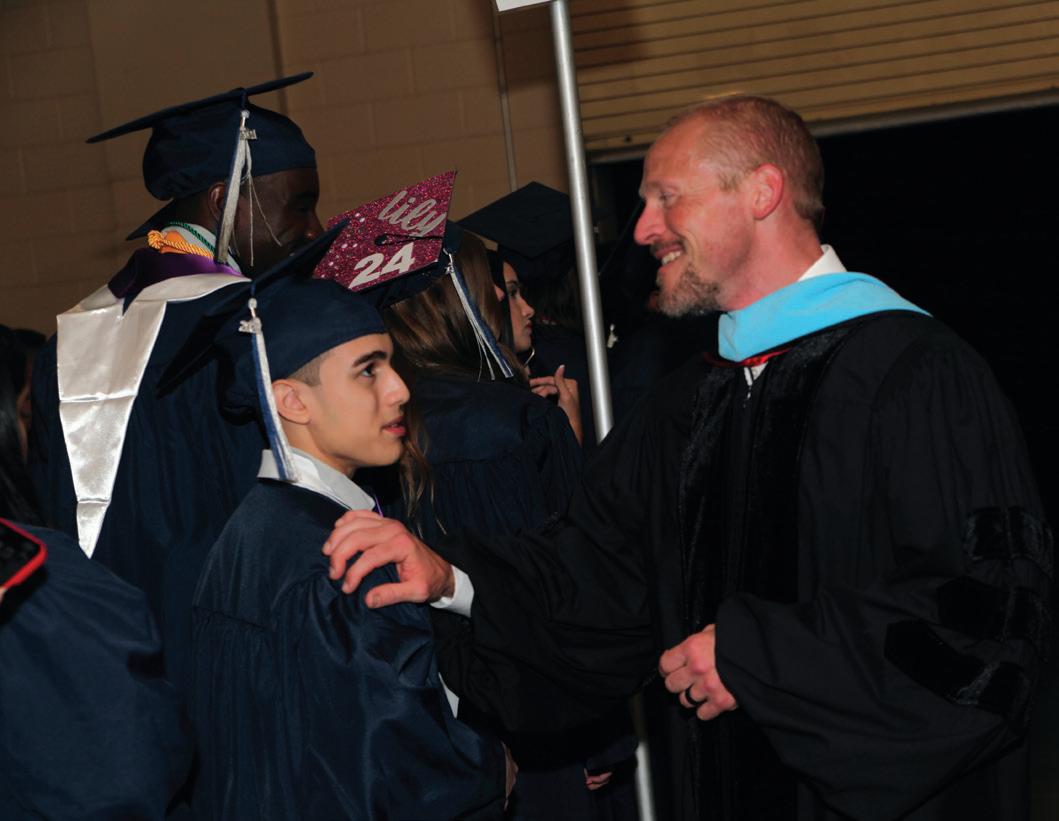
“I always take the approach of trying to make unbreakable connections right out of the gate,” Shepherd said.
He believes in a three-part formula for building relationships as a new superintendent that includes safety, connection, and a shared future.
“I’m not coming in and upending programs. I’m not firing anyone. I’m not bringing people in with me,” Shepherd said about the intentional ways he wanted students, staff, and the community to feel safe. His 100-day listening tour reached a wide audience throughout the district and became an instrument to build connections and a shared future.
“All I’ve been talking about is, ‘I can’t wait to get started building a strategic plan. I can’t wait for you to tell me the work that needs to be done.’ So, I’m trying to build this ‘we' mentality.”
Mitchell praised Shepherd’s approach and the team of eight’s overall collaborative efforts.
“I always look at my position as my community elected me to work with the superintendent and the district,” she said. “Even though we are the boss of the superintendent, it’s very important to work with that person and be that true team of eight. As board members, we are not normally educators or have worked in the school system itself. So, it is very important that we pair our community knowledge and expertise that we all bring to the board with the superintendent’s expertise. He has internal knowledge and focus while we have external knowledge and focus that can help the system.”H
TASB’s Executive Search Services works with new superintendents all over the state to help them get off to the right start with their district and board. Establishing an early rapport with trustees is key to building a strong team of eight.
“Making time to meet with board members one-on-one, especially in the early months of a transition, is crucial to the success of a new superintendent,” said George Kazanas, Executive Search and Field Services officer. “It’s important for trustees to be available and to voice expectations and concerns from the start.”
Additionally, it’s vital for the board to establish a solid foundation for the incoming district leader. TASB’s ESS offers these tips to trustees to foster a successful superintendent transition:
• As a board, review operating procedures and get consensus as to expectations and understanding of the procedures, especially those around communication.
• Meet with the superintendent as a full board two months into his or her tenure to discuss communication concerns and successes.
• Commit to taking the time to get to know each other as a team of eight on a personal level. Having a genuine desire to hear each other’s personal stories and motives for serving can help facilitate increased understanding when challenges arise.
“The first few weeks of a transition are critical. I encourage trustees to reach out to TASB immediately if the relationship with the new superintendent is not resonating,” said Robert Duron, executive leader member support at TASB. “It can take some training to be a good team of eight.”
by Brianna Garcia
Texas boasts a strong and diverse economy. In fact, it is the eighth largest economy in the world with a gross domestic product of some $2.4 trillion. Companies are eager to expand their operations or relocate to the state. But as the economy grows, so do Texas’ employment needs, making workforce development a critical focus for state leaders.
Texas public school leaders are working hard to help address that need. As students in public schools complete coherent sequences of career and technical education courses and earn industry-based certifications, districts are building robust career development programs. The need for practicum experiences, hands-on equipment, and guidance on industry demands are driving forces in career classroom experiences.
Through grant programs, the Texas Workforce Commission has been able to serve as a support partner in this process. Whether located in rural or population-dense districts, TWC collaborates with 28 regional workforce development offices
to identify the needs of the labor market. Alberto Treviño III has served as TWC commissioner representing labor since January 2023. His office is working to enhance strategic partnerships and innovative school programs across the state.
Texas Lone Star talked to Treviño about TWC’s workforce development efforts in public schools. His comments are condensed and lightly edited.
Q: Can you tell us about your role and responsibilities as the commissioner representing labor for TWC?
My role is to represent the more than 14 million working Texans. I work to ensure they’re treated fairly and respected in the workplace. I also work to ensure that Texas workers have access to career development training and good-paying jobs across the state.
Q: What inspired you to apply for this role?
My whole career was in law enforcement, and when I retired, I transitioned to teaching law enforcement classes at Texas Southmost College in Brownsville. I found out the commissioner position was available, and I was encouraged to apply. I was eager to do so because it would be another chance to serve my fellow Texans in a different capacity. I applied, got hired, and then, still in a way, represent my community back home in the Rio Grande Valley.
Q: How does your office collaborate with public schools to support workforce development initiatives?
I meet regularly with our 28 Texas workforce development boards and workforce solution offices across the state. They’re the ones who know their communities very well. They understand the pulse of the local ecosystems in those areas and have strong relationships with the local public schools.
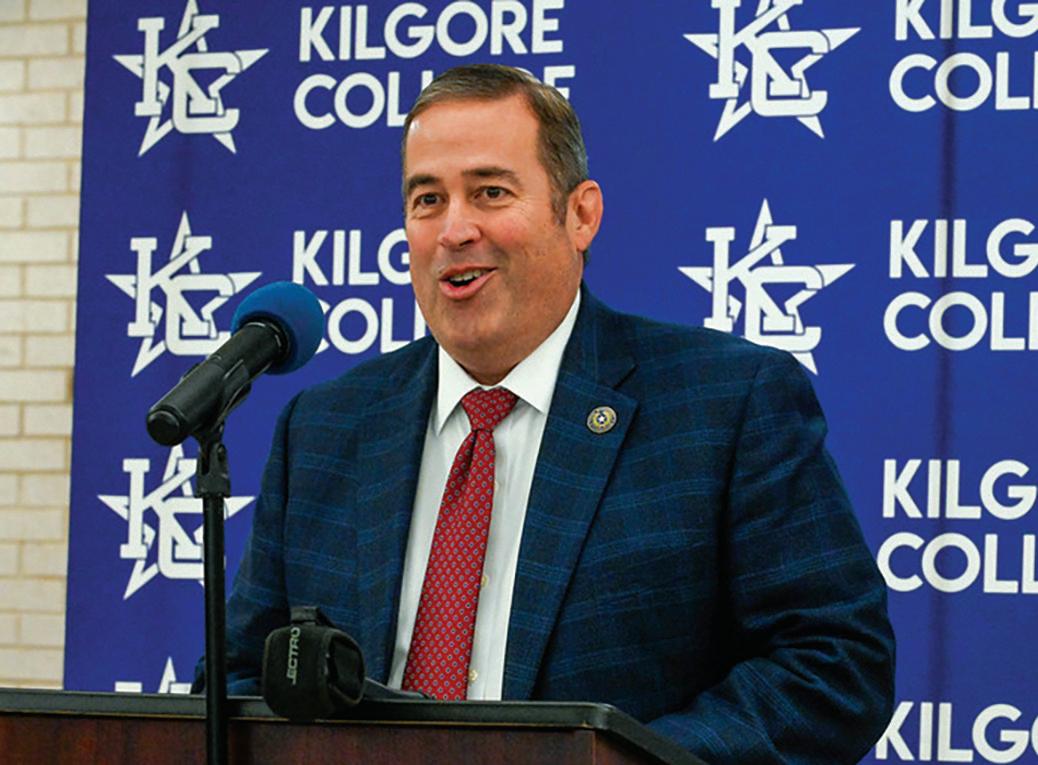
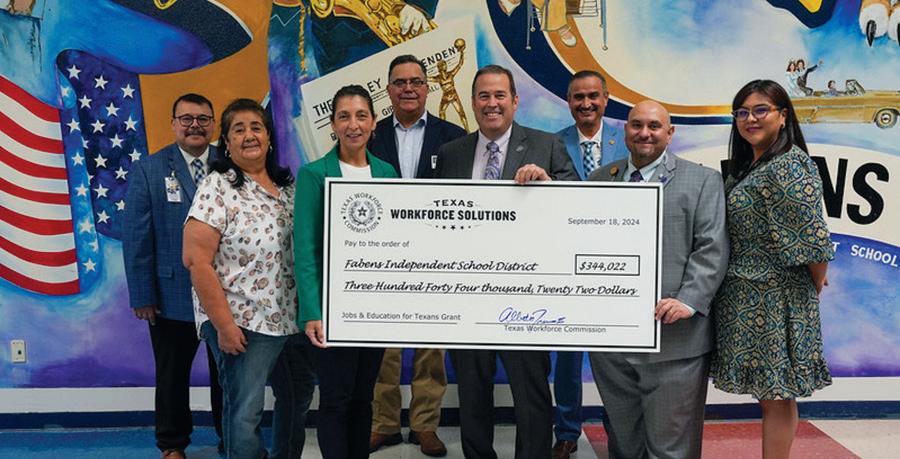

Q: Why do you believe allocating funds to enhance workforce development programs in school districts is important?
It’s important because many school districts don’t have the financial backing they need to keep up with some of the high-demand occupations and some of the in-demand trade industries. Grants assist them [districts] in getting the equipment they need and provide the ability to train the students to compete in today’s job market.
Q: How do improved workforce preparedness programs contribute to the state’s overall labor development?
We get to target the in-demand jobs that are in the area or that are coming to Texas. Many industries, not just manufacturing but tech industries, seek to do business here. We need a workforce that can compete to take those jobs, and that’s where programs like the Jobs & Education for Texans (JET) grant comes in. We help prepare the workforce through
school programs so that students can get necessary licenses and industry-based certificates, even before graduation. So, when they come out, they’re already one step ahead and can continue their post-secondary education journey, stack on additional certifications, or directly enter the workforce.
Q: What key programs or initiatives has TWC funded in school districts, and how do these programs address the skill gaps in the labor market?
High-demand occupations are the backbone of the programs supported by this JET grant. We’ve funded a variety of systems, including nursing, welding, HVAC, veterinary sciences, and pharmaceutical technician programs. In West Texas, there is oil and gas; mining and logging in East Texas; and a lot of chip industry in North and Central Texas. There are different needs along the coastal region of Texas as well. Because each region has their own unique high-demand industries and
those represented across the state are as diverse as student interests, the JET Grant Program can meet employers and students where they are at by supporting CTE pathways that lead to credentials in high-demand occupations and still represent a diverse inventory of career options for students to train in.
Q: How much money was allotted to school programs in the 2023-24 school year, and how does a school become eligible for the JET Grant Program?
The JET grant awarded $15 million to fund 60 career training grants across Texas. We hope to see a similar number in 2025. Public junior, state, or technical colleges; the Windham School District; and public independent school districts and open-enrollment charter schools — in partnership with a public junior, state, or technical college — can apply for the grants, as determined by statute. Our JET Advisory Board, a six-member panel, meets annually to discuss the regional needs across the state and present a recommendation to our agency on evaluation results. Applicants can apply for a minimum of $40,000 or a maximum of $375,000. We encourage all applicants to carefully read through the Request for Applications documents each year to ensure they develop a competitive and viable grant application.
Q: Tell us about how a region in Texas successfully used a collection of JET grant funds.
A story that stands out is Chapel Hill ISD in North Texas. They were awarded a $210,259 grant to train 119 students as welders, cutters, solderers, and brazers in partnership with Northeast Texas Community College. During that visit, we also awarded five other local rural districts a collective $1.18 million to meet similar apprenticeship needs in the region. Together, this will benefit that region.
Q: How do the 28 workforce offices work with local businesses and industries to ensure school programs align with workforce needs?
The 28 workforce boards communicate with the local businesses, with the school districts, and the economic development corporations, keeping them in pace with what the region needs. The boards are at the heart of working in partnership with our local communities.
Q: Do you have any new initiatives or innovations that you’re excited about in the realm of labor development in Texas?
An issue that was important to me through all my time in law enforcement, and one I still to get to focus on is working closely with our state’s foster youth. When a child turns 18,
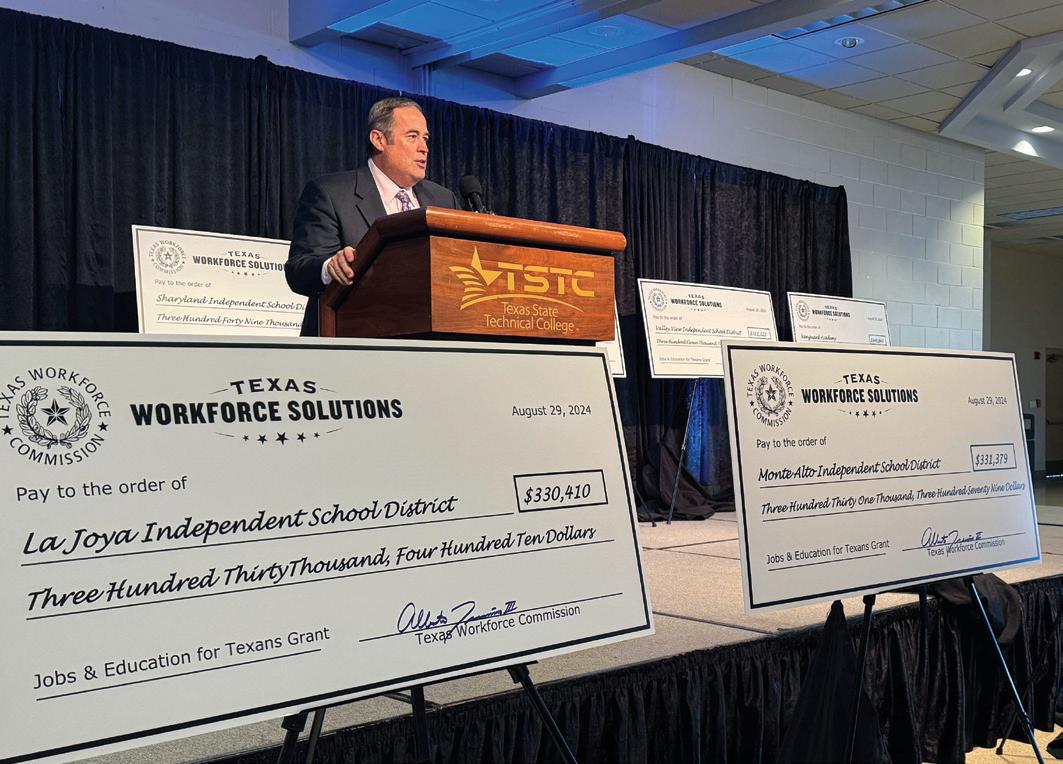
they’re out of the foster care system. I can remember myself at 18 and I would not have been mentally prepared to be on my own and be able to sustain that. I want to ensure our foster youth have the career training they need, and the ability to go to postsecondary school and land a good job. That program is underway.
Q: Do you have any messages you’d like to convey to policymakers, educators, and the public about the importance of the JET grant funding you all provide?
The program has been a huge success. Since its start in 2016, the JET program has awarded over $105 million in [state-funded] grants. In 2023, the Texas Workforce Commission awarded 42 grants totaling more than $11 million to purchase equipment and initially train over 8,000 students in high-demand occupations.
Q: Would you like to share anything else with our readers about the work your office is doing to support the future workforce of Texas?
TWC and our 28 workforce solution boards continue to build our Texas labor force by removing barriers. We focus on highly specialized training that will prepare the workforce for the future, and we continue to upskill Texans to create that pipeline of in-demand workers to meet the needs of employers and regional employment ecosystems across the state, and that keeps Texas the best place to live and work.H
Editor’s note: The Jobs & Education for Texans Grant is a competitive grant process and is now accepting applications for the 2025 JET grant program. Texas public junior, state, and technical colleges; school districts; and open-enrollment charter schools may apply. Information about the application can be found online at twc.texas.gov/programs/jet . To be added to the JET grant email distribution list to receive future announcements, email jetgrants@twc.texas.gov with a request and your contact information.
Brianna Garcia is staff writer for Texas Lone Star
There’s still time to register for Governance Camp, March 5-8, in Galveston! Join us for the conference that empowers the next generation of leaders!
Visit tasb.org/gov-camp for registration information.
Spring Workshops have been scheduled throughout the state. Get training close to home, earn the continuing education credit you need, and network with school board members from your area.
Register at tasb.org/spring-workshops
18-21
Summer Leadership Institute (SLI) is where leadership meets learning! Join us in San Antonio (June 11-14) or Fort Worth (June 18-21). Submit your session proposals by March 15 to share your expertise and influence the future of education leadership.
Find out more at tasb.org/sli
Houston, We’ve Landed! txEDCON25 will take place Sept. 11-14 at the George R. Brown Convention Center in Houston. The session submissions portal for txEDCON25 will be open April 1-May 1. Share your insights and submit your session application for the premier event for the team of eight. Help us shape public education together.
More information at tasa.tasb.org.
P.S. Delegate Assembly is Sept. 13. At your next board meeting, start discussing who will be your board’s delegate and alternate.
by TASB Legal Services
As the second semester continues, superintendents and administrators should begin evaluating whether to recommend the nonrenewal of certain educator contracts to their school boards. Following is information and steps to consider in the nonrenewal process.
Educators employed under term contracts leave districts involuntarily by one of two ways — nonrenewal or termination. It is important to understand the difference between nonrenewal, which occurs at the end of a contract, and termination, which occurs during the contract. Unless the district takes affirmative steps to prevent contract renewal, an employee will be entitled to work at the district in the same professional capacity for the subsequent school year. Tex. Educ. Code § 21.206(b). Therefore, nonrenewal is a decision not to rehire an employee at the end of the current contract. An employee may be nonrenewed only for reasons set forth in local policy DFBB (LOCAL). By contrast, termination occurs during the contract term and is essentially the same as a discharge (i.e., being fired). A midcontract termination of a term contract requires a showing of good cause based upon egregious misconduct, very poor performance, or unusual circumstances.
Nonrenewal only applies to term contracts. Although termination of a probationary contract at the end of the contract term is often referred to as a “nonrenewal,” it is technically a contract termination. Probationary contracts may
be terminated at the end of the contract term based on the board’s determination that termination would be in “the best interests of the district.” Tex. Educ. Code § 21.103(a).
Continuing contracts are similar to tenure status in higher education and remain in effect indefinitely. This means the contract continues until it is terminated either by the employee’s resignation or by the district for good cause. Since these contracts are indefinite, the concepts of renewal and nonrenewal do not apply.
Texas law requires nonrenewals to be based on established reasons outlined in a district’s employment policy. Tex.
Educ. Code § 21.203(b). These established reasons can be found in local policy DFBB (LOCAL). While districts have broad discretion in setting these reasons, Texas law stipulates they must be lawful, reasonable, and supported by substantial evidence. Tex. Educ. Code § 21.209.
First, the superintendent will present a list of contract renewals and nonrenewals to the school board, and the board will decide which contracts to propose for nonrenewal. Once the board determines which contracts it will not renew, it must notify, in writing, each employee whose contract is about to expire, no later than the 10th day before the last day of instruction, whether the board proposes to renew or not renew the contract.
The notice must be delivered personally by hand delivery to the employee on the campus at which the employee is employed. If the employee is not present on the campus on the date that hand delivery is attempted, the notice must be mailed by prepaid certified mail or delivered by express delivery service to the employee’s address of record with the district. Notice that is postmarked on or before the 10th day before the last day of instruction is considered timely for these purposes. Tex. Educ. Code § 21.206(a). It’s important to remember that if the board

fails to give timely notice of a proposed renewal or nonrenewal, it constitutes an election to employ the contract employee in the same professional capacity for the following school year. Tex. Educ. Code § 21.206(b).
After the employee is given notice, they can request a hearing no later than the 15th day after receiving hand delivery of the notice of proposed nonrenewal. If the notice is mailed by prepaid certified mail or delivered by express delivery service, the employee can request a hearing no later than the 15th day after the date the notice is delivered to the employee’s address of record with the district. The board must provide a hearing no later than the 15th day after receiving written notice from the employee requesting a hearing, unless the parties agree in writing to a different date. If the employee does not request a hearing, the board can move forward with the nonrenewal and notify the employee in writing of the board’s action no later than the 30th day after the date the notice of the proposed nonrenewal was sent. Tex. Educ. Code § 21.208.
The nonrenewal of a term contract requires having sufficient documentation, following strict deadlines, and ensuring an employee receives a fair hearing. Nonrenewals also have a high possibility of being appealed to the commissioner of education, so it is important to follow the correct process and work closely with your school attorney. As always, TASB Legal Services is here to help if you have questions. Call us at 800-580-5345 H
This article is provided for educational purposes and contains information to facilitate a general understanding of the law. References to judicial or other official proceedings are intended to be a fair and impartial account of public records, which may contain allegations that are not true. This article is not an exhaustive treatment of the law, nor is it intended to substitute for the advice of an attorney. Consult your own attorney to apply these legal principles to specific fact situations.

Whether you are planning for the next year, decade, or generation, find the bond investment solution you need with Lone Star Investment Pool. Contact our experienced team for advice on investing any amount and to see how Lone Star can help your district achieve its financial goals.
by Dax González
The Texas legislative session is now in full swing, though both chambers are in the early stages of organizing and conducting other business. We’ll continue to keep you updated on all the happenings in Austin throughout the session.
Meanwhile, it’s worth noting that there was a busy close to 2024 for public education in Texas and beyond. In Texas, the State Board of Education had a productive meeting and bade farewell to a few members. In addition, political insiders spent the last couple of months of 2024 parsing through election results, and voters in other states said no to vouchers.
The SBOE at its November meeting adopted new high-quality instructional materials (HQIM) required by House
Bill 1605 (88th regular legislative session), passed new requirements for school board trainers, and recognized three members who left the board.
The approved list of HQIM includes K-5 English language arts and reading and Spanish language arts and reading, K-3 English and Spanish phonics, and K-12 mathematics. The approved instructional materials are intended to be aligned with state curriculum standards and will be an option for school districts that choose to use them beginning in the 2025-26 school year.
The SBOE also strengthened eligibility requirements for school board trainers by requiring background checks for individuals seeking to be trainers, prohibiting political advocacy during training sessions, and requiring registration for all individual trainers instead of allowing entities to be registered.
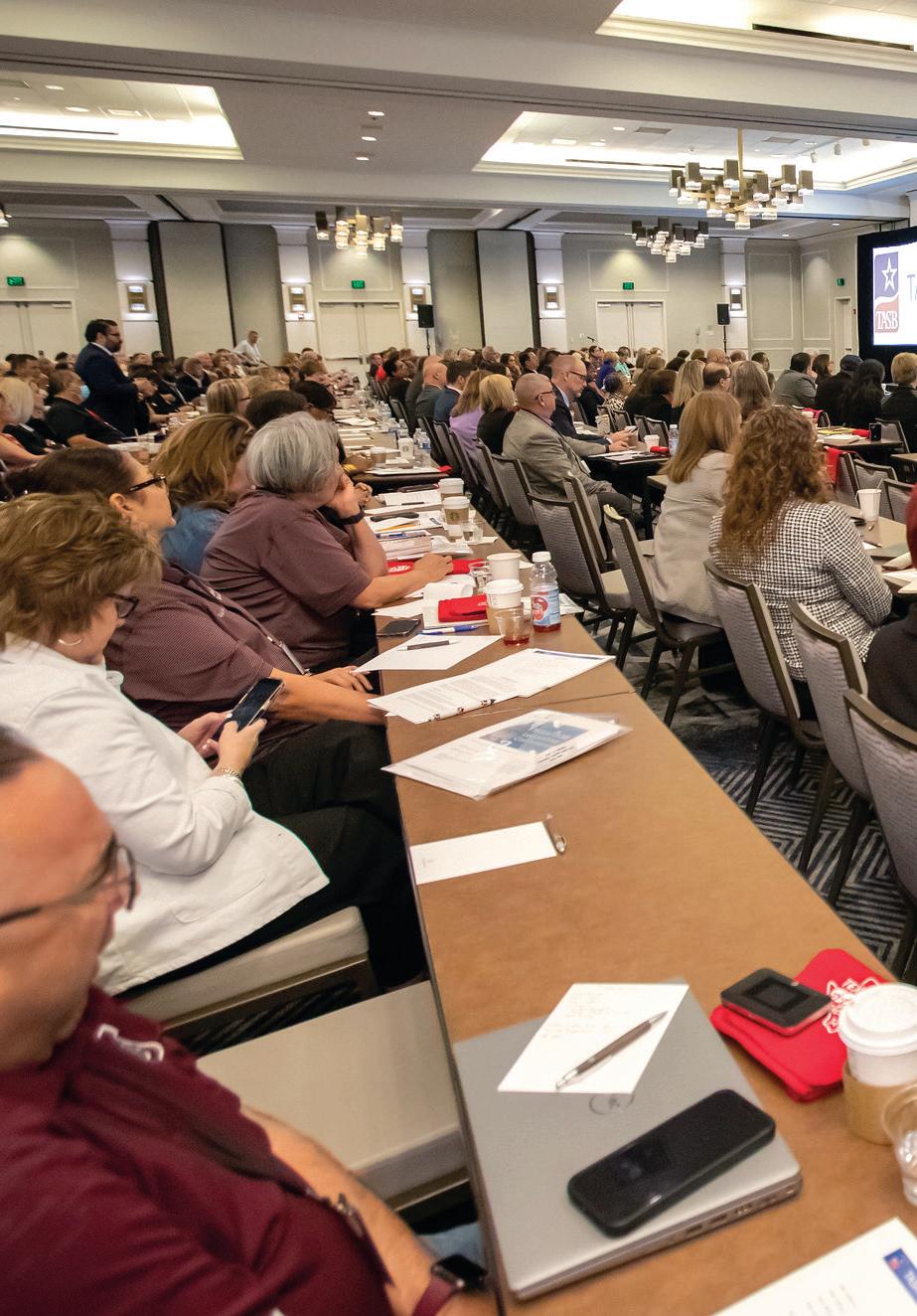
Members also honored three board members who left the board for their service: Aicha Davis (D-Dallas), Patricia Hardy (R-Fort Worth), and Melissa Ortega (D-El Paso).
The November elections brought little change to the overall makeup of the Texas House and Senate, where Republicans continue to hold majorities in both chambers. Republicans gained

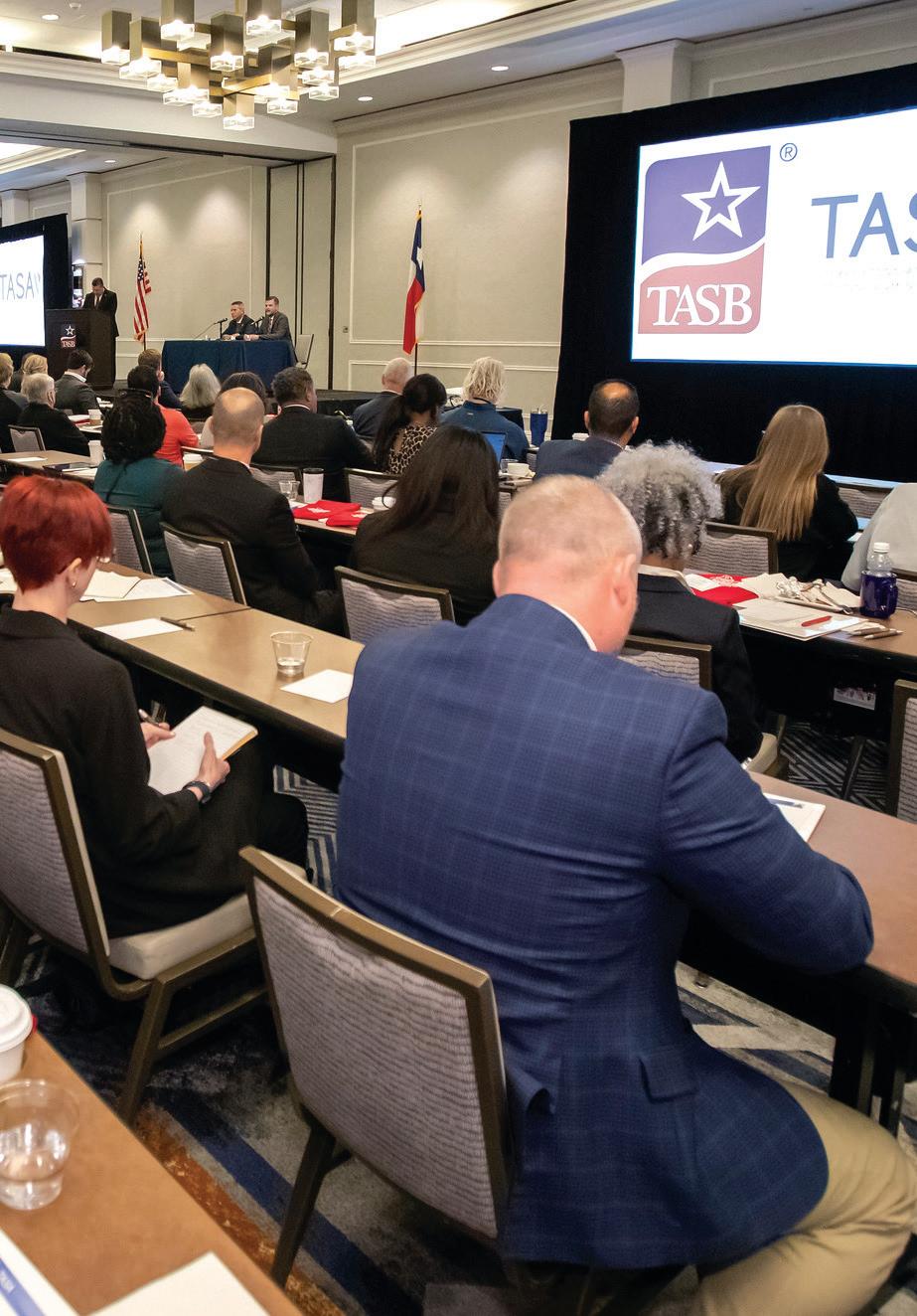
two seats in the House and will hold an 88-62 majority, compared to the previous 86-64 majority. Over in the Texas Senate, Republicans gained one seat to increase their majority to 20-11.
Republican Don McLaughlin won Uvalde’s House District 80 to succeed retiring Democrat Tracy King, while Republican Denise Villalobos in Corpus Christi’s House District 34 won to succeed retiring Democrat Abel Herrero. Republican Adam Hinojosa defeated Sen. Morgan
LaMantia, D-Palm Valley, to take Senate District 27.
While some are claiming that vouchers were a certainty after the primary elections in March, a lot will depend on the details of the various voucher proposals expected to be filed this session. Some proponents of private school choice are calling for little to no transparency or accountability of the program, while others would like to see guardrails around any program using public tax dollars.
In SBOE races, incumbents who ran all reclaimed their seats. Republican incumbents Tom Maynard (District 10), Pam Little (District 12), and Aaron Kinsey (District 15) won their elections, and Democrats Marisa Perez-Diaz (District 3) and Staci Childs (District 4) won their contests.
New faces on the board include Republican Brandon Hall, who won the District 11 seat previously held by Pat Hardy (R-Fort Worth); Democrat Gustavo Reveles, who won his District 1 race to replace El Paso Democrat Melissa Ortega, who decided not to seek another term; and Democrat Tiffany Clark, who won the District 13 seat vacated by Aicha Davis.
Meanwhile, voters in Kentucky, Colorado, and Nebraska defeated voucher propositions presented to them on their statewide ballots in November.
In Kentucky, voters rejected, 65% to
35%, Constitutional Amendment 2, which would have allowed their state legislature to provide funding for nonpublic school voucher programs and charter schools.
In Colorado, voters rejected by a margin of 52% to 48% Constitutional Amendment 80, which would have allowed their state legislature to provide funding to nonpublic school students.
In Nebraska, voters approved, 57% to 43%, Referendum 435, which will repeal legislation that allocates $10 million annually for the state’s private school scholarship program.
Don’t forget to register for the upcoming TASA | TASB Legislative Conference scheduled for Feb. 18 in Austin. Attendees will learn about education issues at the Capitol from legislators, TASB and TASA Governmental Relations staff, and other Capitol insiders. This is an excellent opportunity to learn about important legislation that will impact Texas public schools and then visit legislators at the Capitol. Learn more at tasb.org/ training-events/ 2025-tasa-tasblegislativeconference, or scan the QR code.H

González is division director of TASB Governmental Relations.
by Cheryl Hoover
School districts are hiring an unprecedented number of uncertified teachers to meet staffing needs, according to Texas Education Agency data. In the 2023-24 school year, 35% of all newly hired teachers were uncertified — a 5% increase from the previous year.
Implementing a strategic staffing model that embeds collaboration might be one of the best ways to use the talents of teachers while providing valuable instructional supports for inexperienced educators, such as uncertified teachers, beginning teachers, resident teachers in grow-your-own programs, and student teachers. Strategically implementing collaborative staffing models can provide opportunities for educators to learn from each other while sharing the many daunting tasks of teaching and potentially reducing the attrition rates.
teach their own lessons. This model works well when all the team members perform at a moderate to high professional level.
In a strategic staffing model, teachers work in groups and share the duties and responsibilities of teaching based on the expertise of each educator. This collaborative model moves away from teachers isolated in classrooms doing it all themselves. An experienced teacher might teach the lesson to a large group of students in a shared space or through video if a common space is not available. Meanwhile, the more inexperienced educators take on other classroom responsibilities such as managing the technology or assisting students individually — all while having on-the-job opportunities to observe and learn from the skilled teacher.
Teachers can develop more special-
The strategic staffing model uses the talents of available personnel to provide the best possible instruction for students and to strengthen student learning outcomes while improving teachers’ skills.
Strategic staffing differs from traditional teaming of teachers and professional learning communities (PLCs). In the traditional teaming models, teachers work together planning lessons, analyzing data, and managing a shared group of students. After planning, each teacher typically returns to their classroom to
ized responsibilities within the team while honing their skills from observing experienced teachers deliver lessons and manage students in efficient, effective ways. This staffing model uses the talents of available personnel to provide the best possible instruction for students and to strengthen student learning outcomes while improving teachers’ skills.

An example of a strategic, collaborative staffing model is one implemented by Ector County ISD. In 2019, the district struggled to fill more than 350 teacher vacancies. The district has since implemented a strategic staffing model in 13 of its schools. They created teams consisting of teachers, paraprofessionals, and teacher residents led by a “multiclassroom leader,” resulting in a 90% reduction in teacher vacancies.
Using their District of Innovation status, Ector County ISD exempted portions of state requirements, like class size restrictions, and has been able to focus its human capital pipeline away from an annual traditional hiring practice to one centered on talent acquisition and development for collaborative instructional settings.
Other common strategic staffing model configurations districts are implementing include:
• Teams of four to five teachers collectively instruct groups of 50 to 150 students, dividing duties based on skill and expertise. Teams can be created by content or by grade levels.
• Content area specialists provide the initial, direct instruction while the other educators on the team monitor students and take care of other duties.

• The highly effective teachers coteach and mentor other teachers, who take on more instructional responsibilities as the school year progresses.
• Student or resident teachers work directly under a supervising teacher, taking on different classroom instructional responsibilities as they become more skilled in content delivery and monitoring of student outcomes.
• The lead educators teach students half of the day and then provide intensive support and professional development to other team educators the other half.
A nationwide policy analysis released by the National Council on Teacher Quality found that strategic staffing models incorporating collaboration, such as more team teaching or offering different instructional roles for educators, have become more popular across the country. The analysis highlights specific states that encourage innovative strategic staffing models by providing initial funding, allowing flexibility in class sizes, and providing opportunities for district networking.
The NCTQ found that the effort to reimagine teaching has the potential to address challenges faced by students and


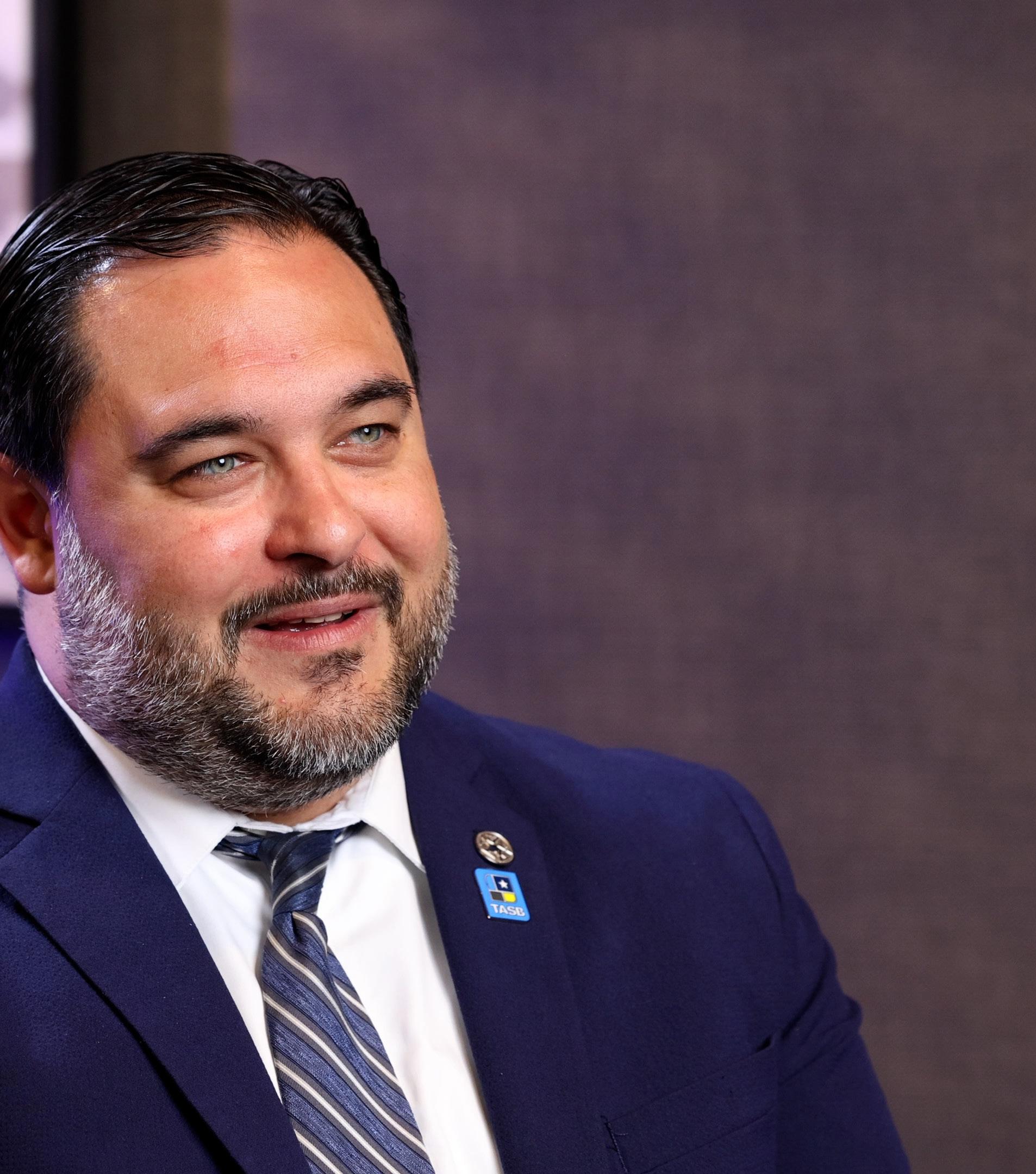
If you’re looking for a group that’s got a lot of experience with diverse communities, that’s cost effective, that’s willing to listen and to work with trustees, TASB ESS is a good choice for you.
– Justin Chapa, president of the Arlington ISD board of trustees
In its more than 30-year history, ESS has conducted over 800 searches on behalf of districts across Texas.
With a team of search consultants who know Texas and its diverse school districts, ESS has proven itself to be the go-to search firm for leadership recruiting.
ESS brings experience to the table and a guarantee, so trustees can feel confident they’ve found the best leader for the job.
tasb.org/ess
executive.search@tasb.org
800-580-8272
Strategic, collaborative staffing can provide the needed instructional support for these teachers while potentially improving retention and morale.
teachers while offering benefits for both. Teachers benefit because this model:
• Ensures more time for collaboration
• Provides “on-the-job” mentoring and professional development
• Fosters better career pathways for teachers and an opportunity for increased compensation in some districts
• Grows strong instructional teams
Students benefit because this model:
• Responds to the needs of all learners
• Gives students access to a variety of teachers
• Creates conditions for teachers to be the most effective in classrooms using their strengths
• Focuses on student outcomes by ensuring students receive robust
learning experiences and exceptional instruction
Of course, teachers must be part of the process when creating collaborative teams. Experienced teachers might not feel comfortable in this group setting. But when they’re presented with the opportunity to showcase their strengths, mentor other educators, and share the workload, typically, they will embrace the model. Additionally, accountability for student learning must be shared and not piled on one or a few teachers. All the teachers should be accountable for student learning, but the day-to-day teaching responsibilities should be divided up and shared based on individual teacher skillsets and strengths.

Uncertified teachers and teachers entering through nontraditional routes are generally less prepared and more likely to leave the profession after their first year. Strategic, collaborative staffing can provide the needed instructional support for these teachers while potentially improving retention and morale.
While there is still limited evidence on the most effective models for collaborative teaching, the flexible strategic staffing approach can provide valuable instructional support to inexperienced educators while lightening the workload for experienced teachers.
Retaining teachers through collaborative staffing can decrease staff mobility concerns, and ultimately, provide greater stability and success for students and the school community.H
Cherly Hoover is a senior HR consultant with TASB’s HR Services.
Services from TASB Facility Services provide expert support for renovations big or small, from asbestos and lead sampling to indoor air quality and pest management. Stay safe, stay compliant – let’s get started.

by Sylvia De La Garza
Editor’s note: Leadership TASB is a unique board development program designed to take experienced board members to a new level of service and leadership by introducing them to a variety of issues, people, activities, and locations.
The Leadership TASB Class of 2025 held its November meeting in El Paso, where trustees visited local districts and schools to learn more about their successes as well as the struggles they are facing.
On day one in the Sun City, the city’s nickname thanks to its sunny weather most of the year, our class toured San Elizario ISD, also known as the Proud Community of Champions. The district is led by Superintendent Jeannie Meza-Chavez.
We made several stops during the tour, including Josefa L. Sambrano Elementary, Lorenzo G. Loya Primary School, Fernie Madrid Eagle Park, the U.S.-Mexico border wall, Ann M. Garcia-Enriquez Middle School, San Elizario High School, and the district’s administrative offices.
As trustees prepared to learn more about how individual schools approach their challenges, we considered the importance of public education in Texas and how district staff, trustees, teachers, and community members are working hard to make a difference in public school students’ education.
During our visit to San Elizario High School, LTASB members were taken through the school’s Pathway of Champions monuments, which honor
students and show the pride they have in their school. This display not only reflects students’ excellence in sports, but it also serves as a reminder that although there may be many obstacles, they are still able to overcome those challenges.
While at San Elizario, we were also introduced to several programs offered at the district. The trustees could see how much pride the participating staff and students have in these educational opportunities. We learned how the Advancement Via Individual Determination program helps students academically.
A panel of students shared their experiences and explained how the AVID program has encouraged them to let their true skills shine, while also sharing how it has allowed them to take ownership of their education and better understand that everyone faces struggles. LTASB
members also learned about the e-sports club and some of the CTE programs that are offered, such as cosmetology, biomedical, and culinary classes. As a bonus, the trustees had the pleasure of enjoying a great meal the students prepared.
Trustees then visited Josefa L. Sambrano Elementary and Lorenzo G. Loya Primary schools, where they were treated to a traditional cultural folklore dance performance by elementary students.
Touring the classrooms, trustees could see and feel the pride that the students had in themselves. During a stop at Fernie Madrid Eagle Park, trustees learned how San Elizario ISD places a lot of focus on home and the school community.
The next site visit was to the U.S.-Mexico border wall, which stirred a mixture of emotions for some class members as they learned more about the district’s partnerships and the challenges faced in educating their students. Nevertheless, the district maintains focus on its “Purpose and Passion” in educating students, ensuring they too can become part of the culture as they grow to become part of the community.
During a stop at Ann M. GarciaEnriquez Middle School and the San Elizario ISD administrative offices, trustees learned more about the district’s determination to support all of its students no matter what their circumstances. Students may come from a variety of backgrounds with different challenges, and the goal is always for the district to meet them where they are and support them. As educators, that is the purpose and mission displayed at San Elizario ISD.

On the second day, class members visited El Paso ISD, which is led by Diana Sayavedra. The district is also known as the “Pioneer of Public Education” and trustees learned why during site visits to Green Elementary School, Young Women’s STEAM Academy, and El Paso High School. At Green Elementary School, trustees discovered how traditional and nontraditional education formats are being combined to provide students educational opportunities. The district provides a traditional format and a Montessori program all under one roof. What came through was the pride the leadership felt in making sure every student received the best education, regardless of whichever path a family chose to take.
At the Young Women’s STEAM Academy, it was clear that the students learn to feel empowered to dream big and to never accept NO as an answer. The programs offered at the school are shaped by students, who also have a seat at the table when decisions are made. The best part of the Young Women’s STEAM Academy is the student-teacher bond that is created. Students feel safe due to the support they receive.
The final stop in the Sun City was at El Paso High School. A panel of students conducted the tour, which put a spotlight on the pride, culture, and history the school has from its founding back in 1916. The school, located on a mountainside overlooking the city, is known as “The Lady on the Hill.”
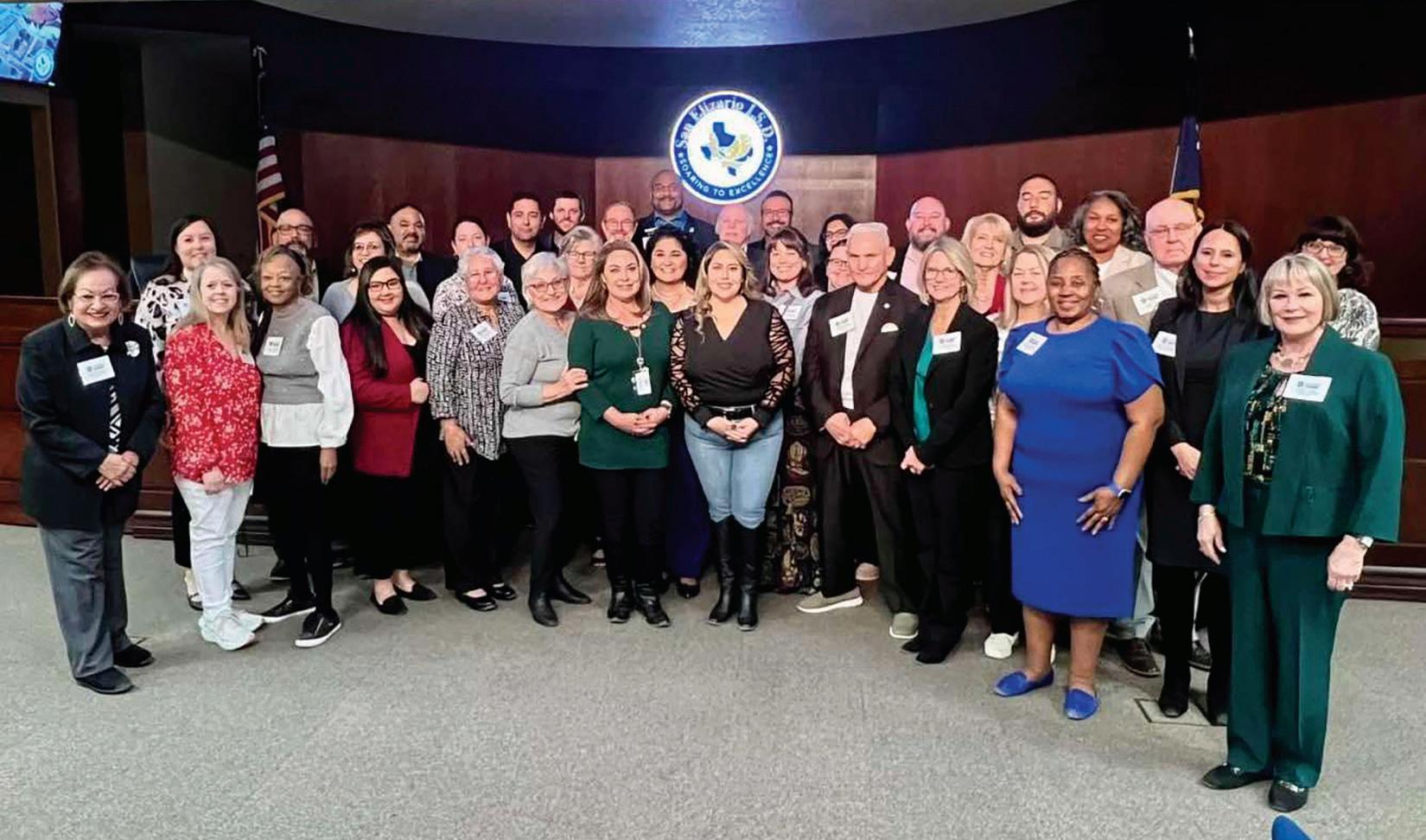
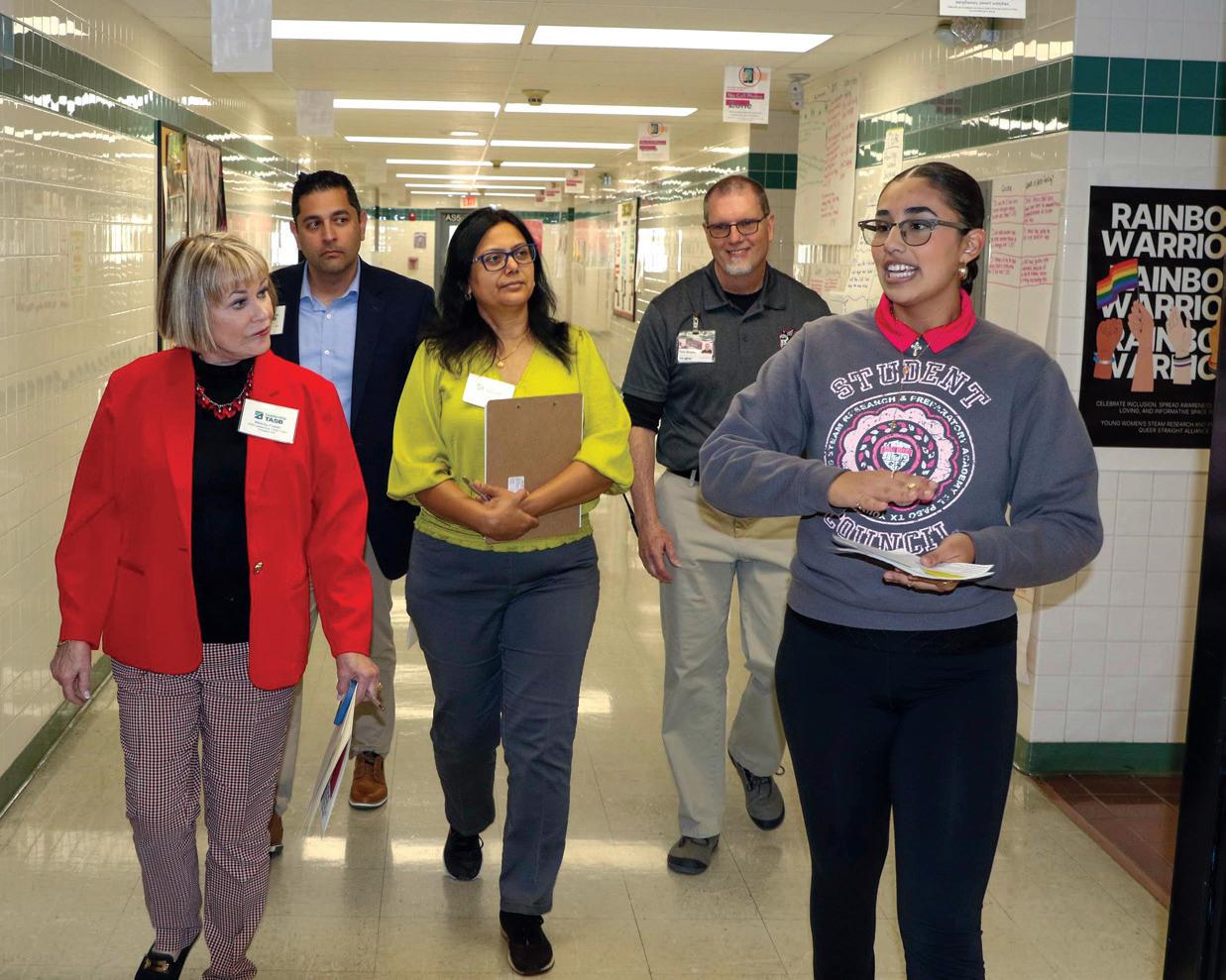
The class heard from Sayavedra and Israel Irrobali, the board president, who shared the struggles and challenges El Paso ISD is facing. Recent data show a continued decline in district enrollment, which could total up to 1,000 students per year for the next decade.
To address this concern, the district has conducted more than 40 community meetings and has received feedback that will help officials make the best decisions possible to ensure that every student receives the best quality education, while also implementing the best programs needed to accomplish this goal. The superintendent and board have had to make some unpopular decisions. El Paso ISD said it plans to propose the closure of 10 elementary campuses out of 48 by the start of 2025-26 school year.
As we visited these locations and learned about their challenges, we realized we are not alone in our own struggles and, more importantly, our successes.
The El Paso trip served as a valuable reminder of the important roles the board and the administration play in supporting students.
We learned more about governance and how to separate the roles of the board and administrators, allowing the administrative experts to do their jobs and to keep the board informed as needed.H
Sylvia De La Garza is a Plainview ISD trustee and a member of the LTASB Class of 2025. She is also a trustee on the TASB Risk Management Fund Board.
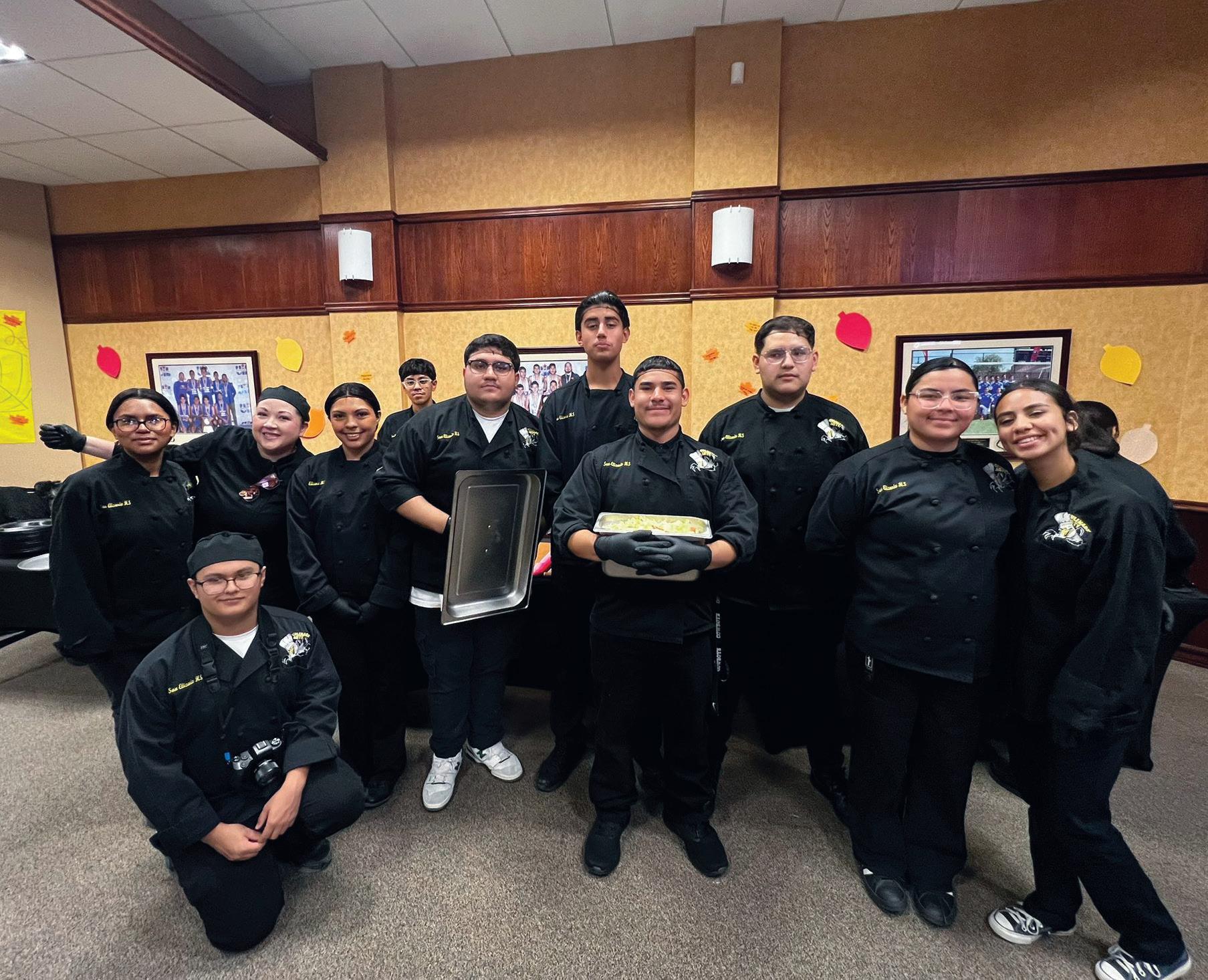
The median salary for a Texas school superintendent in 2024-25 is $153,176, an increase of 2.1% from the prior year, according to the annual TASB and Texas Association of School Administrators’ Superintendent Salary Survey.
The survey is conducted each fall to help school districts across the state understand compensation trends. Of all the responsibilities entrusted to school board members, among the most important is hiring and evaluating a superintendent, said Amy Campbell, director of TASB HR Services, which administers the survey.
“As districts wrestle with budget constraints, current compensation data helps school board members develop a compelling pay and benefits package to recruit or retain the best superintendent for their district,” Campbell said.
This year’s survey included participation from 755 districts, representing 74% of districts in Texas and marking a higher rate of participation from last year. There was a wide variation in median salaries based on district size, with a range from $115,000 in districts with fewer than 500 students to $362,250 in districts with enrollments of 50,000 or more.
The survey also looks at trends in superintendent experience. Of the 132 districts in Texas reporting a new superintendent in 2024-25, 91 school boards, or 69%, hired a superintendent with no previous experience in the position. This is consistent with the number of districts hiring a first-time superintendent in 2023-24.
Campbell said the overall trend has stayed relatively constant in recent years. New superintendents generally have prior experience as a deputy or assistant superintendent, so they’re not entirely new to a district leadership role.
Another data point of interest is the amount of time that superintendents spend in that role in their district. The median is about three years, which
remains unchanged from last year. The median experience for superintendents overall is four years total.
Salaries comprise only one part of a superintendent’s overall compensation package. The survey results also include data on bonuses, transportation benefits, health insurance benefits, and cell phone reimbursement, all of which can add significant value.
“We always want to provide school board trustees with resources and information to help them make the best financial decisions,” Campbell said. “The survey data provides insights that can be used to develop superintendent contracts that reflect the market while bridging the needs of the district with that of its top leader.”
TASB HR Services sends a survey invitation via email to all 1,019 school districts across the state. Salary data from districts with interim and part-time superintendents is not included. Survey findings can be found at tasb.org/resources /hr-library/salary-survey-highlights H


Don’t let special education operating procedure updates weigh you down.
TASB Student Solutions can do the heavy lifting by giving you:
User-friendly procedures
Time back to focus on students
No fee for annual updates
studentsolutions@tasb.org
tasb.org/student-solutions
“Education is the movement from darkness to light.”
—Allan Bloom
Nominations are open for the 2025 Superintendent of the Year Award, established in 1984 to recognize excellence and achievement among district leaders in Texas.
School boards that want to have their superintendent considered for the award are encouraged to submit a nomination packet to the regional education service center by the April 18 deadline.
“We always look forward to the SOTY process each year as it provides an opportunity for school boards across the state to highlight and share the great work and practices of their superintendents,” said Dan Troxell, TASB executive director. Nominations submitted by school boards are reviewed by regional committees set up by each ESC, which select a winner to
put forward to the state selection committee.
Among those regional winners, the state selection committee narrows the pool to five state finalists announced over the summer. Finally, a Superintendent of the Year is selected each year in the fall at txEDCON.
Those considered for this prestigious honor must display:
• Exemplary and visionary leadership toward improving student performance
• Strong leadership skills
• Dedication to improving the quality of education in their districts
• Commitment to public support and involvement in education
For details about how to nominate a superintendent for this award, please visit tasb.org/soty.H
TASB’s Executive Search Services is currently accepting applications for these positions listed below:
▄ Borger ISD: Superintendent Deadline: March 17
▄ Central Heights ISD: Superintendent Deadline: March 19
▄ Dell City ISD: Superintendent Deadline: February 19
▄ Groesbeck ISD: Superintendent Deadline: February 23
▄ Holland ISD: Superintendent Deadline: February 26
▄ Hudson ISD: Superintendent Deadline: March 7
▄ UT High School Special Purpose District: Superintendent Deadline: TBD
For information about vacancies or services provided by TASB’s Executive Search Services, call 800-580-8272, email executive.search@tasb.org
Join us for TASB’s Summer Leadership Institute, where leadership meets learning. This premier training event is designed to offer new and experienced school trustees a place to create their own learning journey. Attendees will have the opportunity to participate in a variety of sessions that cover the latest trends, best practices, and innovative strategies in school board leadership.
“As a new trustee, I have found TASB to be an excellent resource to expand my understanding of public education in Texas as well as how to be a valued member of the team of eight,” said Donald Henderson, a Los Fresnos CISD trustee, who is in his fourth year on the board. “My first year at SLI, I attended the new board member workshop, which laid the foundation for understanding our work as trustees. I've attended SLI every year since, learning from speakers from various districts who face similar challenges and find creative solutions. SLI has helped me become a more educated public servant.”
Take part in SLI at one of two locations: San Antonio June 11-14; or Fort Worth June 18-21. TASB’s Texas Trustee Institute, an immersive learning experience designed for new board
members, and Board Officer Institute, a program designed for trustees who are either officers or interested in a board leadership role, will be offered at both locations.
The call for session proposals is now open and will close March 15. This is your chance to share your expertise and contribute to the future of education leadership by discussing the initiatives your board and district have been working on. In addition, working with your colleagues to develop a presentation is a bonding experience.
Don’t miss this opportunity to network with peers, gain new insights, and enhance your leadership skills at SLI. For more information, visit tasb.org/sli H
H April 18: Nomination submissions due to designated ESC
H June 30: Regional screening completed and nominations submitted to TASB
H Aug. 22-23: All regional winners interviewed and five finalists chosen by TASB State Selection Committee
H Sept. 12: Finalists interviewed and Superintendent of the Year chosen by TASB State Selection Committee
H Sept. 12: Presentation of the award at txEDCON25 in Houston
Entry documents for the SOTY award program can be downloaded from tasb.org/soty. Questions? Call us at 800-580-8272 or email soty@tasb.org





Public education advocate Doug Williams, retired Sunnyvale ISD superintendent and past president of the Texas Association of School Administrators, has been chosen to join a select group of Texans to receive the Golden Deeds Award, a coveted award for distinguished service to education in the state. Williams was presented with the award at the TASA Midwinter Conference in late January.
TASA and the Texas A&M University Department of Educational Administration and Human Resource Development co-present the Golden Deeds Award each year to an individual from any profession who has improved the educational system in Texas to enrich the lives of all Texas public school students.
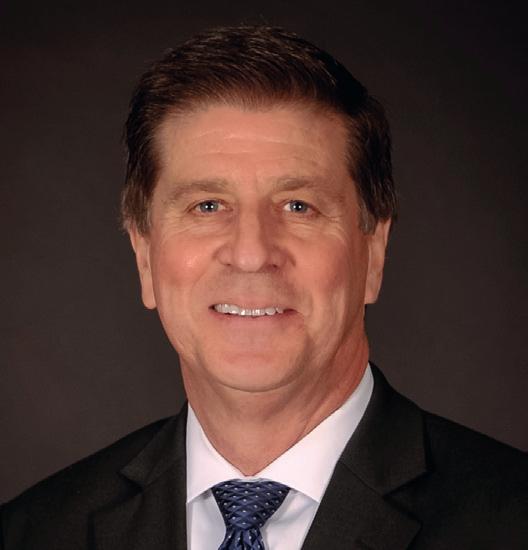
board members, superintendents, and teams of eight: TASB’s annual Spring Workshops are back, bringing training directly to you at locations across Texas.
The workshops are an opportunity for education leaders to earn continuing education credits, explore topics of regional interest, and connect with other education leaders.
“At TASB, we know our members are always learning and growing so they stay informed and can be of service to their districts,” said Dan Troxell, TASB executive director. “We listen to our members, who tell us the workshops they want to meet their continuing education requirements, while also offering sessions that address challenges they may be facing in their regions and communities.”
Williams has served as a teacher, assistant coach, athletic director, head football coach, and high school principal in a handful of Texas school districts. He led Sunnyvale ISD as superintendent from 2007 until his retirement in 2023. He also has been a strong and vocal advocate on behalf of Texas public schools, and he served as TASA president in 2021-22.
James B. Crow, former TASB executive director, was the award’s 2023 recipient.
TASB’s Administrative Professionals Conference is Feb. 20-21
Calling all administrative professionals in Texas school districts! TASB is hosting its Conference for Administrative Professionals Feb. 20-21 in Austin, the first of two such events to be held this year.
TASB understands the vital role administrative professionals play in ensuring their district runs smoothly, and the need to provide them with timely and relevant training in all areas of K-12 public education, including legal, policy, personnel issues, meeting management, compassionate leadership, and legislative priorities.
The February conference will be held at TASB’s Headquarters in Austin. This two-day event will feature specialized programming and networking to support administrative assistants who are critical to their district’s success.
Conference sessions will cover a wide range of topics, including:
• Answers to Tough Legal Questions
• The Fundamentals of Policy: Helpful Tools and Resources
• How to Make AI Your Friend
• Working with Your Superintendent to Build Trust and Stronger Outcomes
• Best Practices for Board Meeting Minutes
If you have questions about the conference or want to register, contact TASB at communications@tasb.org
TASB partners with education service centers, colleges, and school districts, which host the events. The workshops kick off March 25 at Region 1 ESC in McAllen at McAllen ISD and are ongoing through May 21, with the final session to be held in Region 16 at West Texas A&M in Canyon.
The sessions offered are selected based on regional feedback and interest. They cover a range of topics, from board development to facility services and human resources to legal services. Among the offerings and in-demand sessions are:
• Child Abuse Prevention: Is Your District in Compliance? This course meets the CEC requirement for child-abuse prevention training.
• Catching up with the Texas Legislature: The course is offered for general session credit.
• Special Education Staff: Why Do We Need So Many?
Learn more about TASB Spring Workshops at tasb.org/training-events/ tasb-spring-workshops.
TASB supports trustees at every point along the board leadership journey, offering training and programs to excel at board governance.
Texas Trustee Institute
TTI offers a comprehensive program to build skills, dive into governance, and develop a leadership network.
Key offerings: Texas Open Meetings Act, Board Governance, Consensus Building.
Coming soon!
Trustees
Leadership TASB
For experienced trustees, meet with innovative districts and leaders, while learning what makes them successful. LTASB’s one-of-a-kind experience will expand your view of education leadership.
Learn more! leadershiptasb@tasb.org
Need support with your superintendent evaluation process? Board Development Services’ consultants are here to help! Get training tailored to your district’s needs.
board.dev@tasb.org
Find on-demand courses for new trustees, including the Top 10 Things to Know bundle of essential courses, in the Online Learning Center.
onlinelearning.tasb.org
Board Officer Institute
For veteran trustees and board officers, BOI imparts knowledge and tools for effective and efficient meetings.
Key offerings: Important Tools for Meeting Preparation, Effective Meetings, Focused and Productive Board Discussions.
Coming soon!
With the Online Learning Center, you can find courses to support your board service, including: Preparing for Superintendent Evaluation, Board Officers Forum, and Advocacy 101 and 201.
onlinelearning.tasb.org
For additional information on any of these offerings: 800-580-8272, ext. 2453 • board.dev@tasb.org
onlinelearning.tasb.org
School board members are the only elected officials in Texas with continuing education requirements set forth by the Texas Education Code.
Much of the training is required for newly elected trustees within their first year, including topics like Orientation to the Texas Education Code, Evaluating and Improving Student Outcomes, and the Texas Open Meetings Act.
There is also the requirement that new trustees get at least 10 hours of training based on the Framework for School Board Development, which decreases to five hours in subsequent years.
Most trustees go above and beyond the required training, which shows their ongoing commitment to continuous learning and improvement on behalf of students. Every year, at the last board meeting ahead of the May or November elections, training reports for school board members are publicly announced.
Source: TASB
Here’s a look at TASB training data for 2024 as reported in TASB’s Continuing Education Credit Report Service (CECRS): Total number of trustees and districts that reported credit in CECRS in 2024:
3,683
Three Boards with the Most Continuing Education Credits Reported in 2024:
reported in Hays CISD
Share Your School District’s Success in Our June/July 2025 “Good News About Texas Public Schools” Issue!
We are inviting school districts to submit inspiring, innovative, and impactful stories that showcase the incredible work happening in our Texas public schools.
Submitting your story is easy! Simply follow these steps:

1. Submit Your Story: Districts interested in participating should submit a short story, 250-400 words.
2. Include Photos: Include at least one 300-dpi jpeg high-quality image that illustrates your story in action.
3. Deadline: All submissions must be received by May 2, 2025.
For more information or to submit your story. Email stories and photos to Texas Lone Star managing editor Laura Tolley at laura.tolley@tasb.org.

